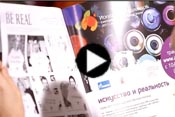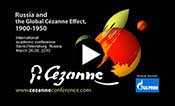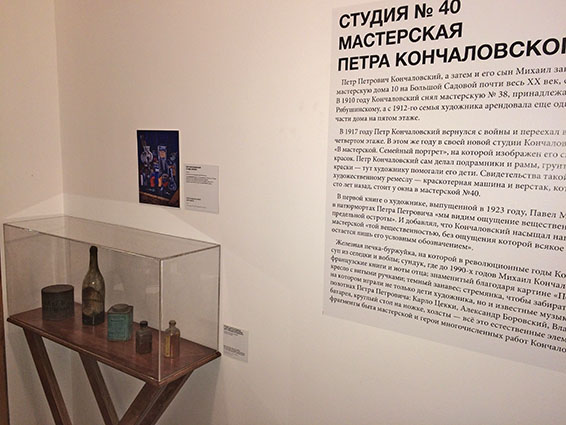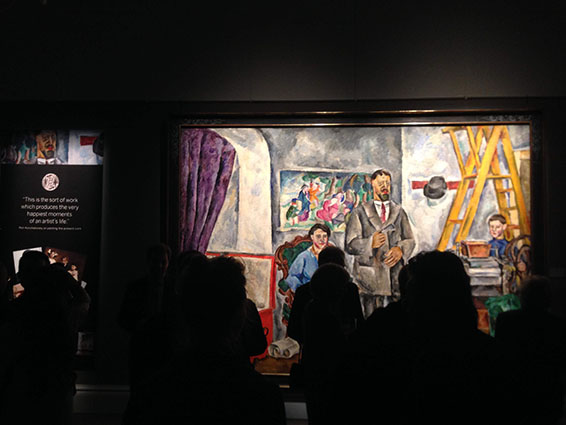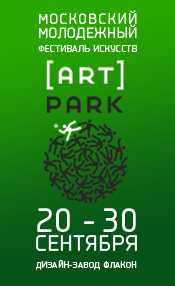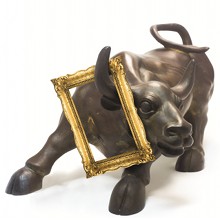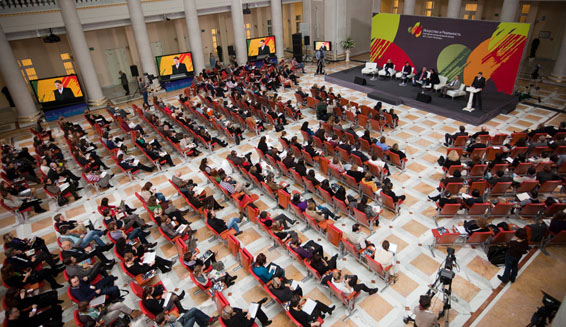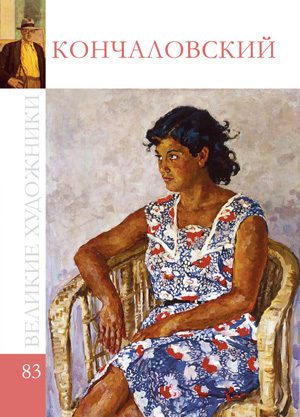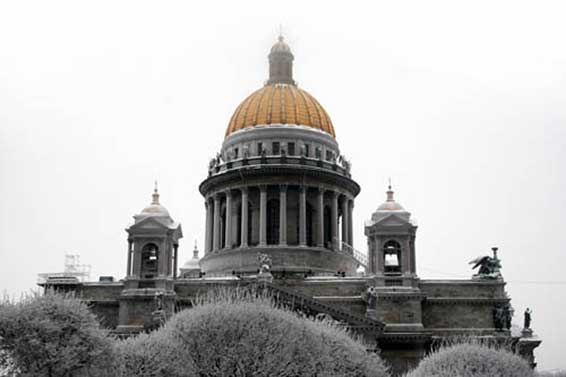|
|
Loading photo archive...
 |
|
1876
Petr Petrovich Konchalovsky was born on February, 21 (9) in Slavyansk in a family of the known translator and publisher Petr Petrovich Konchalovsky (1839-1904) and Victoria Timofeevna Konchalovskaia, maiden name Loyko (1841-1912).
Konchalovskies were the participants of revolutionary movement of 70th years; Petr Petrovich had been arrested and banished into Kholmogory the Arkhangelsk province. After P.P.Konchalovsky’s exile, the manor had been confiscated and the family had lodged at Kharkov.
1880
Konchalovsky junior enters the 3-rd grammar school in Kharkov and studies drawing at private art school of M.D.Raevskaia-Ivanova.
1889
He moves to Moscow where studies in the 1-st grammar school. At the same time he is studying painting and drawing in the evening classes of V.D. Suhov in Central Stroganov School of Technical Drawing
1891
He starts studying painting seriously. Owing to publishing business of the father — gets acquainted with V.I.Surikov, I.E.Repin, A.M.Vasnetsov, V.A.Serov, M.A.Vrubel, I.I.Levitan, K.A.Korovin, etc.
1896
Under his father’s insisting — enters Natural faculty of the Moscow University. However under K.A.Korovin’s influence, he decides to go to Paris to study the painting.
1896-1898
Together with his sister Elena — goes to Paris where enters R.Julien’s Academy. The teachers of Academy J.P. Lorance and J.J. Bendjamin Constant are representatives of so-called Toulouse school.
Often visits the Louvre.
At this time V.A.Serov is petitioning for a delay from a military appeal for P.P.Konchalovsky who should be called up as the simple private soldier for the period of three years as he had no higher education.
1898
In the autumn he enters the Higher Art School at the Academy of Arts in Petersburg where studies at V.E.Savinsky, V.I.Tvorozhnikov and G.R.Zaleman.
1900-1901
He passes into P.O.Kovalevsky’s studio of a battle-piece painting.
1901-1902
He undertakes a trip to Italy (Rome).
1902
February — marries Olga Vasilievna Surikova (1878-1958), a daughter of artist Vasily I. Surikov (1848-1916). At the wedding there were present M.A.Vrubel and V.A.Serov.
Together with Surikovs’ family — goes to Siberia, to Krasnoyarsk.
1903
January, 19 (6) — A daughter Natalia is born.
February — takes part in the X exhibition of paintings of the Moscow Company of Artists in the Historical Museum in Moscow.
1904
September, 28 (15) — His father died.
Konchalovsky undertakes a trip to Italy.
1905
On March, 3 — takes part in the XII exhibition of paintings of the Moscow Company of Artists in the Historical Museum in Moscow.
Undertakes a trip to the North, to Arkhangelsk, Murmansk, Kandalaksha and there writes a picture for competition — ” Fishermen pulling networks “.
After returning to Petersburg — arranges an exhibition of this picture and etudes to it. He does not expose the picture for competition that year.
Goes to Plies, to Volga, makes an attempt to write another picture for competition – «Tea in the summer house». (The picture had been destroyed by the artist).
March, 29 (16) — A son Michael is born.
1907
Konchalovsky receives a rank of the artist for the picture «Fishermen pulling networks»
He gets acquainted with I.I.Mashkov.
Takes a trip to Germany (Berlin).
December — moves with the family to France (Paris, Arles, Saint Maxim, Le Levandou, Nemours), remains there till January, 1909.
1908
April, 15 and June, 30 -He takes part in the XVIII exhibition of the National Society of Fine Arts (Societe Nationale des Beaux-Arts), so-called «Salon de Champs de Mars» in Grand Palais in Paris.
October, 1 and November, 8 — participates in the VI exhibition of Autumn Salon (Salon d’Automne) in Grand Palais in Paris.
He takes part also in an exhibition in the Gallery Weil in Paris.
1909
January — participates in an exhibition of painting, drawing, sculpture and the architecture named “Salon” and organized by S.K.Makovsky in a museum and in Menshikov’s rooms of the First Military School on Vasilievsky island (Universitetskaja nab.) in Petersburg.
February — participates in the VI exhibition of the New Society of Artists in Petersburg.
September — makes acquaintance of A.V.Lentulov.
November — participates in an exhibition of painting organized by I.O.Dudin and V.K.Kolenda in the premises of Literary and Art Circle in the Bolshaja Dmitrovka ul. in Moscow.
December, 27, 1909 and January, 31, 1910 — participates in the III exhibition of paintings ” The Golden Fleece ” in the Khludov’s house (Rojdestvenka ul. 1) in Moscow.
1910
He goes with the family to France.
March, 18 and May, 1 — participates in the XXVI exhibition of Salon of “Artistes Independants” in Paris (Independents’ Salon).
Goes together with V.I.Surikov to Spain (Madrid, Toledo, Grenada, Seville, Valencia, Barcelona).
October — participates in the VIII exhibition of Autumn Salon (Salon d’Automne) in Grand Palais in Paris.
December, 10, 1910 and January, 16, 1911 — participates in an exhibition of “The Jack of Diamonds ” organized by M.F.Larionov in Levisson’s house (the Bolshaja Dmitrovka ul, 32) in Moscow.
At the end of 1910 — February 1911 — participates in the Second International Exhibition (Salon 2. The international art exhibition) organized by sculptor V.A.Izdebsky (Lonzheronovskaja ul. 2) in Odessa.
At the end of 1910 — takes a studio in the Bolshaja Sadovaja ul.10.
1911
January, 13 — participates in the first exhibition of a Society of Artists ” The Moscow Salon ” in Moscow.
January — participates in the XVIII exhibition of paintings of the Moscow Company of Artists in Levisson’s house in the Bolshaja Dmitrovka ul. in Moscow.
February, 26 — participates in an exhibition ” The World of Art ” organized by the Literary and Art Circle in Vostryakov’s house in the Bolshaja Dmitrovka ul. in Moscow.
March, 3 — A ball ” Night in Spain ” designed by P.P.Konchalovsky took place in Merchants’ club in Moscow.
April, 10 and May, 10 — participates in the II exhibition of paintings of the Society of Artists ” The Union of Youth ” in the house of count Baryatinsky at a corner of Admiralteysky pr. and Voznesensky pr. (the Admiralteysky pr. 10/2) in Petersburg.
April-May — participates in the XXVII exhibition of Independent’s Salon (Artistes Independants) in Paris (Quai d’Orsay).
July — participates in an exhibition of the Union of the Consolidated Artists (Allied Artists’ Association) in Royal Albert Hall in London.
The summer — works in Abramtzevo.
November, 1 — “The Jack of Diamonds” is transformed into a society of artists with officially approved charter (on October, 31). The society has existed till 1917. “The Jack of Diamonds” declares as the purpose of the society “the distribution of modern concepts concerning the fine arts”. P.P.Konchalovsky, A.V.Kuprin, I.I.Mashkov and V.V.Rozhdestvensky become the members-founders, P.P.Konchalovsky is selected chairman of board (Kuprin has replaced him lately).
December, 3 and 18 — participates in an exhibition ” The World of Art ” in School of painting, sculpturing and architecture in Moscow.
He translates from French E.Bernard’s book about Cezanne.
1912
January, 21 and February, 19 — takes part in an exhibition of paintings ” The World of Art “, transported from Moscow to Petersburg (Neva, 45).
23 (or 25) January, and February, 26 — participates in an exhibition of paintings of the society of artists ” The Jack of Diamonds ” in a hall of the Economic Society of the Moscow military district (Vozdvizhenka ul, 9).
February, 12 – The first debate “About the modern art” has taken place in the Polytechnic museum, arranged by a society of artists «The Jack of Diamonds» with the purpose to explain the principles of the newest Russian painting.
February, 14 (1) — His mother died.
February, 25 – The second debate “About the modern art” has taken place under P.P.Konchalovsky’s presidency.
March — Konchalovsky’s family accompanies V.I.Surikov to Berlin for treatment of eyes, then moves to Italy (Siena, Pisa, Assisi, Perudgia).
March-April — participates in XXVIII exhibition of Independent’s Salon (Artistes Independants) in Paris (Quai d’Orsay).
The summer — lives with the family in Siena.
October — participates in Autumn Salon (” Salon d’Automne “) in Paris.
1913
February, 7 and March, 7 — takes part in an exhibition of paintings of the society ” The Jack of Diamonds ” in Levisson’s house in the Bolshaja Dmitrovka ul. in Moscow.
February, 24 — In the Big audience of the Polytechnic Museum debates have taken place under presidency of P.Konchalovsky , who in the brief performance has stated principles of art of the society “The Jack of Diamonds”.
April, 3 and May, 1 — participates in an exhibition of paintings of the society of artists “The Jack of Diamonds” in the Concert Hall at the Swedish church of St. Ekaterina (Malaja Koniushennaya ul, 3) in Petersburg.
November, 7 and December, 7 — participates in the International Art Exhibition of the Newest Currents in Art (” Modern Kunst Kring “), arranged by the Society of the Modern Art in Stedelik Museum in Amsterdam.
Makes a trip to the south of France, to the town of Cassis, near Marseille.
1914
February, 5 — 2 (or 5) March — participates in the exhibition of the society of artists ” The Jack of Diamonds ” in the premises of Society of Amateurs of Fine Arts in Levisson’s house in the Bolshaja Dmitrovka ul. in Moscow.
February, 19 — Debate “About the modern art” took place in the big audience of the Polytechnic Museum, organized by the society “The Jack of Diamonds”, under P.Konchalovsky’s presidency.
The summer — goes with the family to Krasnoyarsk. He learns about the beginning of the First World War on the way, in Urals Mountains. He is mobilized as the officer-gunner.
December, 6 — the beginning of January — participates in an exhibition of painting and sculpture ” Artists of Moscow — to victims of war ” in Lianozov’s house (Kamergersky per, 3) in Moscow.
At the end of the year — participates in an exhibition of painting ” Artists — to comrades-soldiers ” (Delovoy dvor (the Business court), I.T.Amirov’s premises, Varvarskaja pl.) in Moscow.
1915
Having got under bombardment, Konchalovsky has been contused and evacuated for treatment in rear – spends two months in hospital in Nara.
March, 23 — 5 (or 26) April — participates in ” The Exhibition of Painting of “1915?” in Art Salon (Bolshaja Dmitrovka ul, 11) in Moscow.
April, 12 and May, 9 — participates in ” The Exhibition of Painting of the Left Currents ” in N.E.Dobychina’s Art Bureau (Marsovo pole, 7) in Petrograd.
1916
February and March, 25 — participates in an exhibition of painting “The World of Art ” in Petrograd.
March, 19 (6) — Vasily I.Surikov died.
March — leaves the society “The Jack of Diamonds” and enters the society “The World of Art “.
On April, 3 -19 — participates in the Exhibition of Modern Russian Painting in N.E.Dobychina’s Art Bureau (Marsovo pole, 7) in Petrograd
The council of The State Tretjakov Gallery gets Konchalovsky’s work — “Portrait of N.P.Konchalovskaia, daughter of the artist” (1915-1916).
December, 10, 1916 and January, 14, 1917 — participates in an exhibition of etudes, sketches and drawings ” The World of Art ” in Petrograd.
December, 26, 1916 and February, 2, 1917 — participates in an exhibition of paintings of the society “The World of Art ” in Art Salon in Moscow.
1917
February, 19 and March, 26 — participates in an exhibition of the society “The World of Art ” in N.E.Dobychina’s Art Bureau in Petrograd.
June, 14 – As a result of the references of the Moscow artists to military minister, he is released from military service.
Cooperates with Council of Working Deputies and Council of Soldier’s Deputies.
July — together with I.I.Mashkov, A.V.Lentulov and N.Shestakov heads the Art Commission at Committee of the Feminine Union ” The Help to the Native Land “.
Together with the family he goes to Crimea, to Sudak.
August — is invited to participation in the Moscow Council on Affairs of Art.
December, 27, 1917 and February, 2, 1918 — participates in an exhibition of paintings ” The World of Art ” in Art Salon in the Bolshaja Dmitrovka ul, in Moscow.
1918
After demobilization — lives in Moscow in Bolshaja Sadovaja ul, where there were his studio and an apartment.
October, 1 – Together with A.V.Lentulov and P.V.Kuznetsov he is chosen to head the painting studio of the II State Free Studios of Art (GSHМ) in the VHUTEMAS where he taught till 1921. Among his pupils were: S.Bogdanov, P.Vilyame, A.Labas, А. Lebedev-Shuysky, V.Novozhilov, G.Sretensky, A.Taldykin, etc.
December — He is included in the list of artists whose products should be bought for the Museum of Painting Culture (MJE). In 1919 the State Fund of the Museum bureau has transferred to IJE following products of P.Konchalovsky: “Model”, “The Still-Life with a Samovar”, “The Family Portrait “, “Landscape”, “The Model at an Oven “.
1919
February, 19 — participates in the V State exhibition of paintings (1918-1919) in the Museum of Fine Arts in Moscow.
May — participates in the first exhibition of IBMOHU (the Society of young artists) in former Stroganov School in Moscow.
June – participates in the exhibition of new purchases (for the period of 1918) in The State Tretiakov Gallery in Moscow.
September — December — participates in the I State exhibition of paintings of local and Moscow artists in Vitebsk.
1920
Konchalovsky is included into the Council of Masters, which is organized for protection of professional interests of artists instead of former Trade Union of Workers of Art.
January, 17 – He is chosen the member of the board of the Council of Masters. Later the Council is transformed into INHUK (the institute of art-culture).
The summer — works in Abramtzevo.
December — participates in the exhibition of paintings of Russian artists in Pskov and in the first State exhibition of art and science in Kazan.
1921
Summer (June) — His works are presented at an exhibition of new purchases in the State Tretiakov Gallery.
Works in Abramtzevo.
October-November — participates in an exhibition of products of painting, sculpture and architecture of the society ” The World of Art ” in Moscow.
1922
January — participates in an exhibition of products of artists of the society “The World of Art ” in Moscow.
April — The first personal exhibition in the State Treiakov Gallery takes place.
October-November (on other data, on October, 15 — the end of December) — participates in the first Russian Art exhibition in Gallery Van Dimen (Unter den Linden, 21) in Berlin.
1923
January — In Moscow, in a publishing house “Tvorchestvo” (Creativity), the first monograph about the artist — P.P.Muratov’s ” Konchalovsky’s Painting “, sees the light.
May, 14 — June — Konchalovsky’s works are shown at the first Russian art exhibition in Stedelik Museum in Amsterdam. The works are transported there after exhibition in Berlin.
May — participates in a group display of paintings in Moscow.
June — participates in an exhibition ” Theatric and Scenery Art of Moscow 1918-1923 ” in the Museum of Decorative Painting in the Bolshaja Dmitrovka ul.
1924
March, 9 and April, 15 — participates in an exhibition of Russian Art in the Big Central Palace in New York.
The beginning of March — exhibits his pictures at an exhibition organized by the Russian Society of the Red Cross in the Historical Museum in Moscow.
June – participates in the XIV International Exhibition of Arts (biennale) in Venice in Russian section. Konchalovsky’s works are allocated in the separate hall.
He takes a trip with the family across Italy and in Sorrento gets acquainted with M.Gorky.
1925
March — moves with the family from Italy to France, to Paris.
March, 4-19 — The second personal exhibition of the artist takes place in Paris in Chambre Syndicale de la Curiosite et de Beaux-Arts. The foreword to the catalogue was written by the minister of education de Monzie.
March — participates in an exhibition of products of painters and sculptors of the society “The Moscow Painters”.
April, 28 — October — participates in the international exhibition of decorative art and the art industry in Paris (the Grand Palais, Gallery of Esplanades, the Soviet pavilion).
Takes a trip to London.
After returning from France and England — goes with the family to Novgorod.
September — participates in an exhibition “The Left Currents in Russian Painting for 15 years” in the Museum of Painting Culture in Moscow (MJK).
1926
March — The Third personal exhibition of paintings and drawings in The State Tsvetkovskaia Gallery ( Kropotkinskaja nab. 29) in Moscow takes place.
Konchalovsky is awarded with an honorary title “The Honored Worker of Arts of RSFSR”.
February — participates in the IV State art exhibition of paintings of a society of artists “Life” in the State Historical museum in Moscow.
Enters the membership of Association of Artists of Revolutionary Russia (AHRR).
May, 3 and August, 18 — participates in the VIII exhibition of AHRR “The Life and Life-style of Peoples of the USSR” in the agricultural, craftwork and industrial All-Russia exhibition in Moscow and the VIII exhibition of AHRR “The Life and Life-style of Peoples of the USSR” in the Academy of Arts in Leningrad.
1926
He teaches at the theatric-scenery branch in VKHUTEMAS (All-Union Higher Studios of Art and Technology) up to 1927 -and then in VKHUTEIN (All-Union Art and Technology Institute) and in “rabfak” (preparatory courses for workers) for arts.
1927
March — participates in an exhibition of products of artists of group “The Jack of Diamonds” in the State Tretiakov Gallery in Moscow.
March — The IV personal exhibition takes place in the State Historical museum in Moscow.
May-August – participates in the Exhibition of the Soviet Art in Japan: Tokyo, in the premises of newspaper «Asakhi» ( May, 15-31),and then in Osaka and Nagoya (June-August).
In the summer — goes with family to Georgia.
November — participates in the Exhibition of the Newest Currents in Art at the State Russian Museum in Leningrad.
The autumn 1927-1928 — participates in mobile “Anniversary exhibition of the results and achievements for 10 years of the Soviet Authority” on a route: Berlin — Vein — Prague — Stockholm — Oslo — Copenhagen.
1928
January — participates in an exhibition of works of art in commemoration of the 10-th anniversary of October revolution. Moscow.
Takes part in the organization of the Society of the Moscow artists (IIH),which consolidates the members of former societies “Wing”, “Iakovets”, “The Jack of Diamonds” and a number of young artists.
Konchalovsky is a member-founder of IIH.
February, 24- AHRR (The Association of the Revolutionary Artists of Russia) organizes its X exhibition in a building of Telegraph in Moscow in commemoration of the 10-th anniversary of RKKA (The Red Army of the Workers and Peasants),Konchalovsky participates in it.
February — participates in an exhibition of works of art of the Society of the Moscow artists (OMH) in Moscow.
April, 16 — P.P.Konchalovsky’s fifth personal exhibition takes place at the State Chamber Theatre in Moscow.
1929
January — Council of national commissioners appoints for P.P. Konchalovsky the lifelong special pension at a rate of 225 rubles a month.
Finishes teaching activity in VHUTEIN.
March-June — The Sixth personal exhibition takes place in the State Russian Museum in Leningrad.
Participates in the international exhibition in Pittsburgh, the USA (Carnegie’s Institute).
The end of 1929 — the beginning of 1930 — The personal exhibition takes place in Crimea.
1930
March – Konchalovsky carries out the Seventh personal exhibition in the Moscow State University.
1931
The summer — lives in Barvikha near Moscow.
The autumn — goes to Leningrad and Ryazan.
In the winter — comes back to Moscow.
1932
January — The Eighth personal exhibition takes place in halls of VSEKOKHUDOZHNIK(All-Russian Cooperative-Partnership of Artists) (Kuznetsky most, 11) in Moscow.
The winter — gets a residence in Bugry (a part of Obninskys’ former manor “Belkino”) near Maloyaroslavets, in the Kaluga area.
Goes to Leningrad to work on the scenery for the State Academic Bolshoy Theatre.
November, 15, 1932 — May, 1933 — participates in an anniversary exhibition “Artists of RSFSR for 15 years” in halls of the State Russian Museum.
1933
June, 20, 1933 and February, 12, 1934 — participates in an anniversary exhibition “Artists of RSFSR for 15 years” in halls of the State Historical Museum in Moscow.
The autumn — makes a trip to Kutaisi.
1933-1935
Lives and works in Bugry.
1936
The summer — goes with family to Murmansk, Kirovsk, and then to the Far North where the Tulomskaja hydro station was under construction.
1937
Goes to Kirovsk and to Apatity.
1938
Goes to Khokhloma.
March, 30 – the Ninth personal exhibition takes place in the halls of VSEKOKHUDOZHNIK (the Kuznetsky most, 11) in Moscow.
1939
With his son Michael Konchalovsky goes to Caucasus.
1940
February, 15 — The evening of the creativity of Konchalovsky is arranged by edition board of the newspaper “The Soviet Art”.
1941
March — The Tenth personal exhibition is organized by the Moscow Partnership of Artists in Moscow in connection with the 65-th anniversary from the date of a birth and the 35-th anniversary of creative activity of the artist.
With the beginning of the II World War the artist remains in Moscow with his family, and lives in the house in Konjushkovskaja ul.
1942
Konchalovsky has received Stalin Premium of the First Degree “For long term of creative activity”.
1944
November 1944 — March 1945 — The Eleventh personal exhibition takes place at the State Small Academic Theatre in Moscow.
1945
April — The twelfth personal exhibition takes place in the Central House of Workers of Arts in Moscow.
1946
In connection with the 70-th anniversary from the date of a birth and the 40-th anniversary of creative activity P.P. Konchalovsky is awarded with the honorary title of the “National artist of RSFSR” and decorated with the Order of the Labor Red Banner.
April — The Thirteenth personal exhibition is arranged in the Regional museum in Krasnoyarsk.
1947
He is selected as a full member of the Academy of Arts of the USSR.
February — The Fourteenth personal exhibition is organized by the Moscow Partnership of Artists in Moscow in commemoration of the 40-th anniversary of creative activity of the artist. The catalogue is issued with introductory article of K.S.Kravchenko “Petr Petrovich Konchalovsky. Fifty years of creativity”.
1949
November, 6 — participates in the All-Union Art Exhibition organized in halls of The State Tretiakov Gallery.
November, 2 — A number of works of P.P. Konchalovsky, A.T. Matveev and S.V. Gerasimov had been removed from the exhibition.
1951
March — The Fifteenth personal exhibition takes place in the halls of Academy of Sciences of the USSR ( Kropotkinskaja ul, 21) in Moscow. The catalogue is issued with Vsevolod Ivanov’s introductory article.
1956
February, 2 – P.P. Konchalovsky has deceased. He is buried on Novodevichie cemetery in Moscow.
The XVI personal exhibition passed in Moscow and the XVII personal exhibition — in Leningrad. Exhibitions were accompanied with the catalogue with N.Sokolov’s introductory article “For the Memory of Petr Petrovich Konchalovsky (1876-1956) “. |
|
1880-1906 “The early years” |
 |
 |
 |
In 1880 Petr Konchalovsky enters Kharkov private school of Raevskaia and studies drawing there. At the same time he gets acquainted with artist Levchenko, visits his studio and tries to work with paints.
After arrival to Moscow in 1889 he continues studying painting and drawing in the evening classes at V.D.Suhov in Central Stroganov School of Technical Drawing. He writes a number of portraits, including a portrait of his sister – Victoria Petrovna Konchalovskaia. His father shows the portrait to Surikov who marks the “Spanish color” of the young artist.
Owing to publishing business of his father, the young man gets acquainted with artists V.I.Surikov, V.A.Serov, M.A.Vrubel, K.A.Korovin and others. He often visits studios of V.A.Serov and K.A.Korovin. The painting of the last especially strongly influences young Konchalovsky. The young man often visits museums as well. The great impression is made on him by the Tretiakov Gallery.
He tries to illustrate Pushkin’s «The miserly knight» on his own.
At that time the young man often visits museums. The great impression is made on him by the Tretiakov Gallery.
In 1895, the French Art-Industrial Exhibition is opened in Moscow. There, for the first time the artist sees the works of impressionists. The strong impression is made on him by Monet’s “Stacks”.
Konchalovsky tries his forces in sculpturing. In 1896 on Vrubel’s models, he has molded of clay a group “Robert and Bertram”. It was made in wide plans for a ladder in Morozov’s private residence in Spiridonovka (the composition was finished by Vrubel for casting of bronze).
In 1896, according K.A.Korovin’s advice young artist goes to Paris to study painting. He enters Julien’s Academy – a private art studio where teachers, J.P. Lorance and J.J. Bendjamin Constant, were representatives of so-called Toulouse school. A drawing of the young artist is awarded and hung as the sample on a wall of studio. In Paris he writes an etude on a mythological plot “Odysseys and Calypsos”, noted by teachers, but not satisfactory for the author. He also writes “The Feminine portrait”.(1898).
The artist understands the necessity of painting from life and studying of the nature and goes to Brittany, where writes a series (about hundred) etudes on post-card size wooden plates.
In 1898 he comes back to Russia, goes to visit his friends in the Tver province in the autumn and works in Venitsianov’s studio – writes etudes of Russian autumn.
Konchalovsky enters the Higher Art School at the Academy of Arts in Petersburg where studies at V.E.Savinsky, V.I.Tvorozhnikov and G.R.Zaleman, after a while passes into P.O.Kovalevsky’s studio of battle-piece painting.
Meanwhile P.P. Konchalovsky senior begins the edition of the collected works of A.S.Pushkin and has involved in that task many artists who before it had participated also in work of the edition of Lermontov’s compositions. Konchalovsky junior takes part in the edition of 1899 (“A.S.Pushkin’s Compositions” – P.Konchalovsky’s anniversary edition in 3 volumes – Moscow: Company “Printing House of A.I.Mamontov”, 1899).
1901-1902 – Konchalovsky often goes to make etudes in Rozhdestvenno near Petersburg.
Studying in Academy, the artist is engaged in making the scenerys for students’ and amateurs’ theatricals. Receives the first premium for sketches of scenery of the academic ball where together with the scenery of a hall makes the scenery for an alive picture “Frina in Elevzise”. He also executes the scenery of the Parisian street for the play at Yavorskaia’s theatre and scenery for the “Snow Maiden” under V.M.Vasnetsov’s sketches for “country” theatre of V.S. Serova.
After a marriage to Olga Vasilievna Surikova (February, 1902), he goes together with Surikovs’ family to Siberia, to Krasnoyarsk where writes etudes. A series of etudes is noted by teachers and exposed at the academic exhibition, but his own works do not satisfy the artist, and he personally destroys much of the studies written during this period.
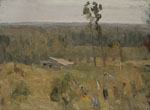
Siberia. Taiga. 1902
In 1904 artist goes to Italy where writes the first etude in the impressionism manner (“A Small Garden near Rome – Peaches in Color”), but after returning to Petersburg he continues working in the academic tradition.
The work on the portrait of his wife which he has begun in Rome is continued.
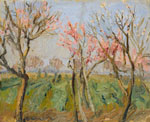
Garden near Rome. Peaches in Bloom. 1904
He writes a series of academic works of liberal choice of themes. His “Lads going to a conversation party” has wined a premium, and “Shrovetide Feast” has pleased Kovalevsky so that he tried to persuade young artist to write his competition work on this theme.
Konchalovsky passes lots of time in botanical gardens making sketches of animals.
In 1905 he takes a trip to the North to Kandalaksha, and there, right on the shore, he writes his competition picture – “Fishermen pulling Networks” (in 1935 the author had washed the picture away). After his return to Petersburg young artist exhibits the picture and the etudes in private, but decides to avoid the competition this year (in 1907 he achieved the rank of artist for this picture). He goes to Plies on Volga and tries to write another competition picture – “Tea Party in a Summer House” (later he destroyed the picture).
This summer he also writes a curtain and makes row drafts for the scenery for Misset’s opera “Mughette”, and Bruno’s “Hurricane” for S.I. Zimin’s Theatre of Opera. Although the sceneries have been made in wide pictorial manner quite new for the time, the experts decorators are pleased. They invite Konchalovsky to join their partnership on making theatrical sceneries for provincial theatres.
|
|
1907-1909 “Impressionism” |
 |
 |
 |
P.P.Konchalovsky reckons his art activity from 1907.
The artist more and more interests in the impressionists painting and after the termination of studying in the summer of 1907, writes a number of etudes in the impressionism manner. He lives near Moscow at the period.
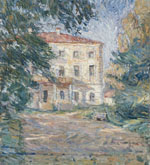
House in Belkino. 1907
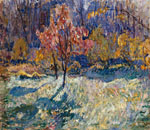
Belkino. Garden. 1907
In the autumn of 1907 he goes to Germany (Berlin), in December moves with the family to France (Paris, Arles, Sainte Maxime, Le Levanter, Nemours) and remains there till January, 1909.
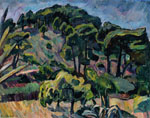
France. Lavandou Mount. 1908
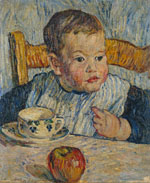
Paris. A Boy with an Apple. 1908
In Paris he frequents the Louver and is interested in pre-Raphaelites’ art.
The artist is amazed with painting of Cezanne and Van Gogh.
I instinctively understood even at those years that without some new method there is no salvation – it is impossible to find the road to the real art. That’s why I have grasped at Cezanne as a drowning one would grasp at straws”.
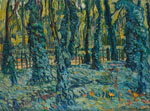
Versaille. Ivies. 1908
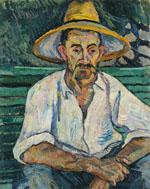
Gardener. 1908
Quotation is done out of V.A.Nikolsky’s “Petr Petrovich Konchalovsky” 1936. p.38
Under the influence of painting of Van Gogh he writes the gardens of Versailles and the south French landscapes, and, wishing to learn better his creativity, goes to Arles for a week and there writes a number of landscapes and a picture “A Woman of Arles”.
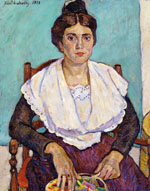
A Woman of Arles. 1908
This is how A.A. Fedorov-Davydov characterizes Konchalovsky’s painting of this period in the article “The Nature of Style” (1929):
“… Process of transformation of additional tones in cooperating colors can be traced and in evolution of young P.P.Konchalovsky, who is typical “neo-primitivist” during this epoch. More directly connected with the French painting, he passed this way easier and more evidently, escaping the notorious “smoky veil” of “impressionism” period.
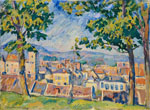
Nemours. 1908
His “Nemours – France”, (1907-1908) is a sample of “optical mixture” of tones in “impressionistic” manner. The sky is formed with brush touches of all shades of blue, pink, lilac, which are participating also and in transferring of trunks of trees. The foliage is made of mass of tones of green and yellow, walls of houses – of yellow, pink, red, dark blue, lilac, pale-green, etc. But in “Palm trees”(1907) the color is already condensed, additional tones form independent adjoining groups exposing green, and in colors on ridges – red and green are contrasting, and the pieces of not written down canvas between them also play a color role; but the ground is still given by tonalities of pink-yellow-brown “.
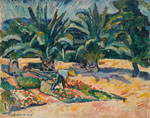
St.-Maxime. Palms. 1908
Feodorov-Davidov – 1975. p.165
In 1909 P.P.Konchalovsky comes back to Moscow.
He makes a plafond for a drawing room in the house of a merchant Markushev in Ivanovo-Voznesensk. Later – receives the additional order to write four panels for a dining room: “Vintage”, “Gathering of olives”, “Harvest” and “Landing of geranium”.The summer he spends in Abramtzevo, writes landscapes, portraits, still-lives of flowers and fruit. At that period he continues working in a manner of “impressionism”.
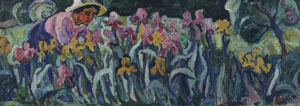
Irises. 1909
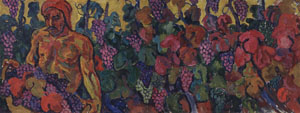
Vintage. 1909
|
|
1910-1916 “The jack of diamonds” |
 |
 |
 |
In 1910 Konchalovsky goes to France again, communicates much with Vasily I.Surikov and studies the “skill of painter’s vision” at him.
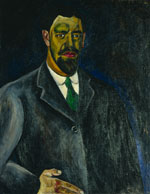
Self-Portrait. 1910
The passion for the French impressionism proceeds.
From Paris he goes with V.I.Surikov to Spain (Madrid, Toledo, Grenada, Seville, Valencia and Barcelona). There he gets acquainted with the art of Velaskes.
From Spain – comes back to Arles, then with a family he rents a villa in Caldetas where on numerous rough drafts and sketches made in Spain, writes a picture «The Bullfight». The artist is interested by national Spanish art, and in work «The Bullfight» he makes the bull very primitive, similar to a national toy, aspiring to show an image most typical.
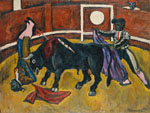
Bullfight. 1910
“Initially I have written «The Bullfight» absolutely realistic, Surikov considered this thing remarkable by vitality of its expression, but I did not like it. I desired to make the bull more typical, not just an animal, as everyone can see it, but similar to a toy in its primitiveness. I always loved folk art – those toy-makers of Troitsk which cut out of wood the bears with the muzhiks all theirs life. With fair simplicity and force they transfer the essence of an animal and the person, using the most elementary means, reducing all to the two-three most characteristic details. I desired to give the fighting bull the same “toy”, “muzhik” simplicity. I wanted it to seem like an awful toy, or even more – a “devil” as it was represented in Middle Ages in churches. So I have rewritten it. I remember, Surikov had considered, that I was mistaken and regretted the former bull, but I liked this new one, more “.
Quot. -V.A.Nikolsky – …the same, 1936 – p.46-47
The Spanish painting changes P.P. Konchalovsky’s palette. Color becomes wormer, shades – gloomy. The artist aspires to reach the Spanish – “simplified synthetic color “.
At that period he writes pictures: “The House”, “The Amateur of Bullfight”, “The Spanish Room” and “Matador Manuel Garta”.
The same year young artist comes back to Moscow and becomes one of the founders of an art society “The Jack of Diamonds”.
The quality of painting is proclaimed as its main advantage. Artists of the society realize the necessity “to work under the rules of new and quite certain method “.
One of the central works written by Konchalovsky after returning from Spain becomes “The Portrait of artist George Bogdanovich Jakulov”.
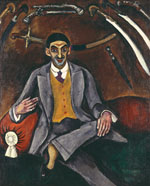
Portrait of the artist G.Jakulov. 1910
The artist characterizes it so: “I wrote Yakulov’s portrait being in a kind of victorious mood, I felt myself to be so strong in painting after Spain. In this portrait, in the most open, barefaced form, I wished to oppose prettiness and smoothness, beloved by many artists, with what is considered ugly in the general opinion, but actually is extremely beautiful. I wished to show the beauty and picturesque power of this imaginary “ugliness”, to show the essence of Yakulov’s character. Benua had learned somehow about this portrait, arrived to my studio and had persuaded to show a portrait at the nearest exhibition of “The World of Art” before it will be exposed in “The Jack of Diamonds”.
Konchalovsky – 796-4 p. 23
The artist spends 1911 in Moscow, leaving to Abramtzevo in the summer, where he writes a series of landscapes, still in the Spanish colors. Then he starts to be interested in Russian folk art and street signboards, and enters them into the city landscapes.
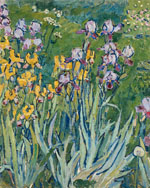
Irises. 1911

Tea-room in Khotkovo. 1911
“The roots of interest to the folk art and signboard of Konchalovsky, as well as of some other artists of an epoch, are in the aspiration which had captured them to express in painting only the most characteristic, and that, using the simplest means. Peculiar to a folk art and to the primitivism as a whole, generalization of forms and extreme miserliness of art language was, in essence, an acknowledgement of Cezanne’s doctrines about synthesis of the form, which made just at that time the triumphal procession in painting of many countries and peoples “.
Nikolsky – …1936 – p.51
Konchalovsky writes his first group portrait of his wife and children (“The Family portrait”, 1911). This picture continues the Spanish series of works of the master.
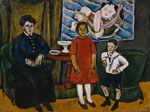
Family Portrait. 1911
Two colors are dominating there in Spanish manner: black and white. The red and green – though strongly given in a portrait – are playing strictly subordinated role and their aim is only to emphasize sonority of two basic tunes of a portrait. The Chinese picture entered into a background serves as accompaniment to these basic tones. It repeats again the black, grey and reflected tones of red (pink gills of a fish) and green (a bluish-green wave). At closer examination of this portrait, there would be already found some first sensations of materiality of subjects, and beginning of “constructivism”. Nikolsky – …1936 – p.53
Together with interest of the artist to the Spanish painting, his interest to creativity of Cezanne continues. In1912, E. Bernard’s book “Cezanne, his unpublished letters and memoirs about him” in P.P. Konchalovsky’s translation is published.
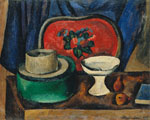
Still Life. Salver and green bandbox. 1912
In March Konchalovsky’s family accompanies V.I.Surikov to Berlin, then moves to Italy (Siena, Pisa, Assisi, Perugia).
In Siena the artist studies frescos of Signoreli, Simone Martin, Benozzio, Gozzoli, Piero Polaiollo. He makes study of the structure of composition, and flatness of forms of old masters.
“The family portrait” is one of significant works of that period.
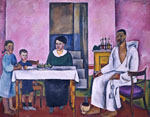
Family Portrait. 1912
The portrait is characterized by a spatial structure of composition aspiring to “fresco” style.
“I have noticed in Siena that people sometimes are taking sit in the Italian room for some reason as if they pose for a fresco. The life itself has suggested to me this circular, fresco construction for the portrait made in Siena. The circularity of composition, its spatiality is precisely emphasized here by a door with a ladder behind my wife, in the highest point of the semicircle. That monumentality of composition of the portrait is also given by Siena. In the color decision I kept to the primitive simplified tones. All is immensely simplified in frescoes as well, though the images represented in them quite often seems absolutely alive. I remember how I was pleased by a small “discovery” made in the portrait in Siena: ones, I have casually put a chair in front of the canvas which stood on the floor, at a wall, and it has appeared, that a chair simply “grown” into the picture, merged with it, despite the simplified nature of forms of the picture. I have tried to put other things in front of the portrait – the same effect, and they merged with canvas. So the secret of the “real” painting, by its qualities opposite to the naturalistic illusiveness, had been opened for me. This “secret” gave me the new strength and new courage, showing me new qualities of the painting which were far from impressionism.”
Nikolsky – …1936 – p. 56-57.
He also writes a series of town landscapes and still-lives in Siena and its vicinities closely studying a structure of natural forms.
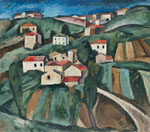
Near Siena. 1912
In the artist’s works of Siena it is possible to track the obvious influence of Cezanne and painting of cubists.
Returning to Moscow, the artist writes a number of still-lives, after the cubists entering into a composition the paper labels. By the master’s opinion, being entered into the picture, paper label forces the artist to raise the quality of painting, leading him up to the achievement of reality – “the tangible transfer of essence of subjects, not running to the measures of naturalistic extremity “.
Nikolsky – … 1936 – p.57.
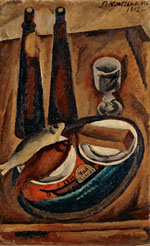
Still Life. Beer and a Roach. 1912
Simultaneously with aspiration to transfer the “essence” of a subject and attempts of decomposition of colors on a flat surface, Konchalovsky studies a constructive method of painting of subjects – cubism.
The works written in this manner are: self-portraits of 1912 and “Model”.
The method of cubism helps the artist to learn to take the most typical from the nature, teaches constructing a composition.
“It was necessary”, – the artist explains, – “to help me to seize the art of taking from the nature the most characteristic, essential, to learn constructing a composition, finally to be quit with traditions of naturalism in painting which restricted me around and with which the enormous part of Russian painting still lived and breathed … “.
Nikolsky – …1936 – p. 58.
In 1912 Konchalovsky carries out sketches of scenery and the suits to A.G.Rubinshtein’s opera «The Merchant Kalashnikov» for S.I. Zimin’s Opera Theatre. Scenery were not kept (had been lost at a fire). Earlier he has created sketches of a curtain for «Hamlet, Piero and the magician» for the Theatre of Miniatures of M.A. Artsybusheva.
In 1913 he makes a trip to the south of France, to the town of Cassis, near Marseilles where creates about ten pictures: views of port, sea coasts, rocks and mountains.
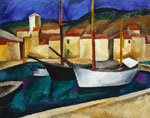
Cassis. Ships. 1913
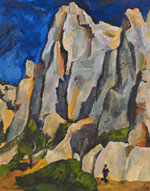
Cassis. Rocks. 1913
-Still continues to work using methods of cubism.
In the summer of 1914 he goes with family to Krasnoyarsk. On a way, in Urals Mountains, they are struck by the news about the beginning of war, and Konchalovsky is mobilized as the officer-gunner.
At war he writes some water colors as instructions to comrades on service, and during two months of stay in Moscow in 1915 paints the portrait “Natasha in an armchair”.
During arrival to Moscow in following year he writes a picture “Violin”.
The work is written in atypical for the artist careful, dry manner and can be considered as a signal of approaching of the new period. As well in the still-lives written in 1916 the turn to realism is observable. In “Agave” – the attention of the artist to the surface of a canvas, to “being processed” of its painting, to quality of the consistence of material is obvious.
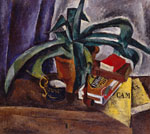
Agave. 1916
“I definitely would like then to process carefully the surface of a canvas. The value of the texture in painting was, certainly, clear to me ever before. I always admired, for example, Renoir’s texture, and the texture of Titian even was specially studied, but the problems of the kind were not arisen yet because there were other, more essential problems. The care of the texture can arise for an artist only when its painting manner has ripened already, and as to me, it had occurred only in 1916. I especially carefully prepared the canvas for “Agave”, and aspired in painting, that the texture of the surface would transfer external properties of subjects: chalky whiteness of a paper leaf, leaves of an agave poured by juice up to resilience, oiliness of the polished wood. The technique of the painting here also was extraordinary to me: I wrote on semidry, ran to the lessenings, used a lot of varnish. But after “Agave” I almost could not get off of the questions of texture, whatever I wrote. The care of a surface became one of components of my manner “. Nikolsky – … – p.63-64.
|
In 1917 Konchalovsky receives clearing of military service and comes back to Moscow. He works much; writes still-lives, portraits, landscapes.
This year a still-life «Workbench» appears, documenting the constant aspiration of Konchalovsky to “self-service” in the field of art. He makes the stretchers, alters the frames, grounds canvases, mills paints. Heavy paint-milling machine is not the less necessary attribute of his studio then the easel…., , Konchalovsky has expressed in his «Workbench» all force of his love to the instruments of production of painter, after having been longing for painting during the long years of war. “
Nikolsky – …1936 – p. 66.
According to his own recognition, by the end of military service the artist has felt necessity of searching of new ways in painting. Together with family he goes to Crimea, to Sudak, and there – tries to write in a quite new manner.
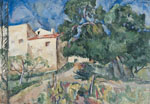
Sudak. Mulberry Tree. 1917
The most typical works of this period are: “The Model at an Oven”, written widely and generalized and the “In a Studio. A Family Portrait”.
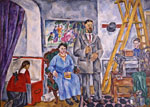
Family Portrait. 1917
“Drawing my daughter’s figure I felt like throwing a challenge to the life itself. How much I succeed in it is another matter, but that was what I wanted. I enjoyed the feeling that I am braiding a real plait of the living person when I was writing a plait in a portrait of my daughter. Enjoyed the thought that by means of nut color paint it is possible to braid almost real plait, to braid it so, that living hair will be felt in it… “.
Nikolsky – …1936 – p. 67.
His painting becomes not only spatial, but also airy.
1918 he spends in Moscow.
Right then the changes are defined which have occurred in painting of the artist. The attitude to the color and light obviously changes; the atmosphere of pictures becomes airy. The epoch of “conquest of color and air” begins.
It is possible to name the works: “The Station Nara”, “River”, “The Bridge in Nara” as the samples of landscapes reflecting the changes occurred.
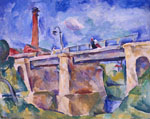
Bridge in Nara. Wind. 1918
The forms are still laconic and simplified. However, the movement of air now is opposed to the stasis of architectural forms.
“The wind tears the clouds running in the sky, brutally shakes a lantern on the bridge, is ready to dump into the river the woman going along the bridge. The immobility of factory pipe heavily perching up only emphasizes and strengthens the general dynamism of the landscape “.
Nikolsky – …1936 – p.69
In the same 1918, Konchalovsky writes his “The Violinist”, the first portrait in his creativity where the human figure is not static but is in movement.
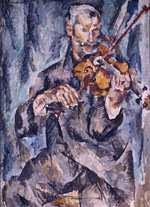
Portrait of the Violinist G. Romashkov. 1918
The artist declares, that the portrait became a turning-point in his painting; he was attracted before by “a substantial being” in the nature but now his task was to transfer the spiritualized condition of the musician.
“Clearly feeling the mathematics and geometry in Bach’s music I wished to construct the portrait as a kind of geometrical figure. Musical sounds somehow transformed themselves into the painted planes on a canvas; the most insignificant musical hints opened the deepest truths of painting.”
Quotation by Nikolsky – …1936 – p.70
The development of airy and light-bringing painting continues for the following years.
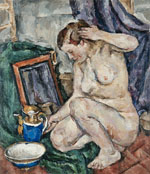
Squatting Model. 1919
In 1919 the artist writes a new series of works: four portraits, some landscapes and a number of still-lives. It is characteristic for these works the light colors scale of palette and silver-ashy pastel tones.
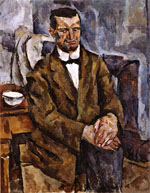
Portrait of the Sculptor P. Bromirsky. 1919
Now he constructs the composition of still-lives more freely and easily, the space breathes, and represented subjects are more realistic than before.
The artist continues solving a problem of transferring a moving body, and also studies the means of painting a person in the nature.
The landscapes of 1919 reflect Konchalovsky’s interest to motives of the nature of Moscow region, earlier met in his works only incidentally. The artist decides to spent the summer of the next year in Abramtzevo where writes an Abramtzevo oak grove and rural landscapes.
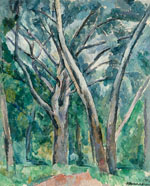
Silvery Poplars. 1919
P. Konchalovsky characterizes so the works of this period:
“In my Abramtzevo oaks there is still, certainly, a coherence of painting to Cezanne’s methods, which I have got used to work with and to which I felt the relationship. But my attitude to the nature now was another. My desire was passionate to create a living landscape, in which the trees would not stick up being simply stuck into the ground as it could be seen often in modern painting, but logically grow from the ground, as those of old masters. The spectator could feel their roots. And for this purpose it was necessary first of all to construct logically each tree, as they construct the building, from the base up to the roof, from the roots which had deeply grown into the ground up to the foliage of tops. / … / before to begin working, to choose finally a place, I wandered in the grove for hours, peered, studied all details. / … / the most important in a wood landscape for me is a silhouette of a tree against the sky, a silhouette of its branches. Old great masters could perfectly do such things, but imitators have turned the fine method into a “trick” of craft and, against my will, I was forced to go through the nature to classics as Cezanne had taught”.
Nikolsky – …1936 – p.78-79
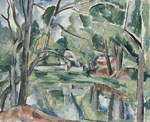
Pond. 1920
Except for the number of studies of an oak grove, in 1920 Konchalovsky writes some portraits and still-lives; however the landscape takes a prevailing place in its creativity for a long time.
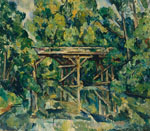
Bridge. 1920
Konchalovsky continues working in the summer of 1921 in Abramtzevo. Now he is interested not only with a day time solar landscape, but also with dawns, twilight, fogs («The Landscape with the Moon», «Twilight»).
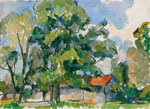
Near the Barn. 1921
He continues working on transferring an image of the nude body in the nature. The artist tries to insert a naked figure into a landscape so, that there would not be felt any artificial connection, trying to reach the integrity and uniformity of a composition. In connection with these searches he addresses to a theme of “bathing” and writes a series of works with the images of bathing people («Female Bathers» and « The Boys Bathing »).
However at that period, the landscape still appears subordinated to a figure, and compositions do not satisfy the artist, being written too solemnly and monumentally. Ever since, an image of the naked body in the nature becomes one of the constant phenomena in the painting of the master.
It is known, that in 1920-1921 the master again, after a long break, comes back to theatrical decoration and scenery. He carries out the scenery for the State Academic Bolshoy Theatre and makes sketches of the scenery and the suits for Bize’s “Carmen”. In 1921 he creates the scenery for an operetta of Offenbach – “Pericolla”, for Stanislavsky and Nemirovich-Danchenko musical Theatre.
|
In 1922 in the State Tretiakov Gallery, Petr Petrovich Konchalovsky’s first personal exhibition is opened. There the drawings and canvases written during the time since 1907 till 1922 have been collected – it is the first public display of all creative way of the artist.
In 1922 the artist spends the summer near Moscow, in Krylatskoe village where he writes the next version of the «Female Bathers». In comparison with the similar work of the last year, the new approach to the decision of a problem of depicting a naked body in the nature is obvious. A landscape appears now the basic subject of a picture, and the human figure is not equal, but is subordinated to it – becomes its part.
The theme of “bathing” is continued with works: “In front of a Mirror”, “The Invalids bathing”.
An outstanding work of this time undoubtedly is “The Portrait of the Artist and his Wife”.
“This time I wanted not “to do” a subject, not to transfer the attributes of its “substantial being”, but “to write” it, to insert a subject into its environment in the picture. The composition was arranged with difficulty, especially the position of hands, and it took a long time until finely they were settled down similarly to an “eight”. By chance, my own face was written at once, but I was forced to work long on the image of my wife. As the entire portrait should have a uniform color decision, my wife had put on a special dress, made by my design: a black velvet corsage and sleeves of the color of bronze. The velvet was written in a complex composition of colors with many paints, up to Indian yellow. And in general I have worked a lot on processing the texture of this canvas, much more, than in “Agave”. There were the dangerous moments during the work: written before was almost spoiled, sometimes I was forced to drop the work, to doubt the future and my forces, my ability to master the problem… This portrait had taken much, too much! “
By Nikolsky -…1936 – p.87
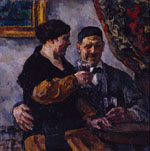
Self-Portrait with Wife. 1923
1923 the artist again lives in Krilatskoe, continues working on landscapes. There he creates the works “The Moon in the Branches”, “Dawn”, “The Night Landscape”, “Ravine”.
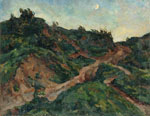
Ravines. 1923
This year Konchalovsky’s first genre works are created: “Harvest”, “The Reapers”, and “Harvesting”.
Thus, since creation of products of 1922-1923, it is possible to speak about the next turn in the painting of artist. His works now are closer to the realistic tradition in Russian painting. It is possible to speak about his final withdrawal from a cubism and “cezannism”. The sensation of the materiality, the reach color now is peculiar to the painting of artist.
Three cycles of works of the artist are concerning to the period since 1924 for 1927, those are: written during his trip to Italy in 1924, – in Novgorod in 1925-1926 and – at Caucasus in 1927.
At Venice Konchalovsky takes a great interest in creativity of Tintoretto and does many sketches of his pictures, writes eight etudes including “The House of Tintoretto”.
At Sorrento he writes a series of studies. “Vesuvius in the Morning”, “Vesuvius in the Evening”, “Vesuvius through the Trees”, “Vesuvius or an Olive Grove”.
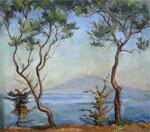
Sorrento. Vesuvius. Two Olives. 1924
On a declaration of the artist, during a trip across Italy he did not put the problems of analytical order but wrote being under the influence of nature.
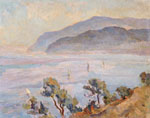
San-Angelo. The Sea. 1924
In March, 1925 Konchalovsky moves with the family from Italy to France, to Paris. The French modern painting pushes him to the decision to return to the analytical painting and to the searches of his own style.
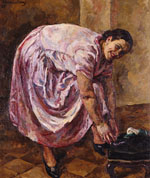
Portrait of N.P.Konchalovskaya. 1925
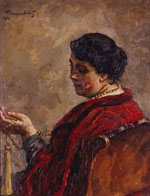
Portrait of O.V.Konchalovskaya. 1925
After returning to Russia the artist goes with the family to Novgorod Veliky. There he creates a new painting series. Three summers on end, master lives near Novgorod, and writes the Novgorod nature and architecture.
As well as in Siena, the artist again is guided by impressions, and direct emotions, absolutely forgetting about the decision to do analytical, “conscious” painting.
In 1926 Konchalovsky writes a great genre composition “Returning from the Fair”.
“In the «Returning from the Fair» I had a conception to impregnate with movement all: the sky with running clouds; the smooth surface of the lake cut around by sailing vessels; the running horses, and the movement of a cart. My desire to transfer real dynamics was so strong that, I even ran near a rushing cart to catch a notion how horse’s legs are settling onto the ground during the run. I have done a special etude of a shaft to seize its line more truly, though I have a good art memory. The theme grasped me so that I couldn’t help falling into absolutely unnecessary naturalism: I even tried to depict the dust from under the wheels for example, where I had only to take the wheels in the essence of their movement that the spectator could see how they are raising the dust. In the real painting, as well as in any real art, there always should be an innuendo, a work should be given for the eyes and a brain of a spectator, or it will be boring, instead of a work of art there will be a report. But I have forgotten all of this during the work, and I was taken too much by the faces, and by the cart, and the harness. And as a result I didn’t get the purpose, was absolutely beaten off from fresco style.
By Nikolsky – … 1936, p.100-101
He continues to write landscapes (“The Rye under the Moon”, “Stacks in the Evening”, “Rainbow”), actively uses motives of a spring high water, “The sunken Gardens”, “The filled in Avenues”, “The Coastal White Willows”.
Two portraits of Father Superior Vissarion: at the divine service in church, and at home – repairing the footwear, also are connected with the Novgorod period. The artist embodies in painting two different aspects of a human life that demands the different creative approaches.
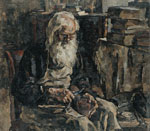
Vissarion - Working Shoemaker. 1926
In the spring of 1927 P.P. Konchalovsky.s studio is unexpectedly visited by a group of Japanese. The artist has been invited to participation at an exhibition of the Soviet art in Japan.
Thus Konchalovsky gets acquainted with the Japanese artist Yabe-San and paints his portrait. And two portraits – Khashimoto and Ikoia – are ordered besides it.
Preparing for the Fourth personal exhibition in the State Historical museum in Moscow, the artist finishes the family portrait begun in 1926 under the name “Misha, bring the beer”.
In the summer of 1927 he goes to Georgia where writes a series of mountain landscapes and the genre products frequently with an epic shade.
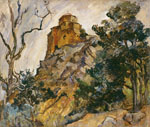
Mtsiri. Storm. 1927
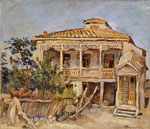
Mtskhet. Sandro-Saklia. 1927
A canvas “The Shoeing of a buffalo” remains as an artistic result of Konchalovsky’s travel across Georgia.
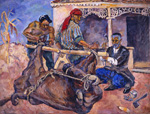
Shoeing of a Buffalo. 1927
In 1928 he goes to Novgorod again. This time landscapes are rare, special attention is paid to the citizens (“The Fish market”, “At Ilmen-lake”).
During his residence in Novgorod, the master opens new in his creativity painting motive – a landscape through the window.
After returning to Moscow creates a portrait of Japanese actor Todzjura Kavarasaki.
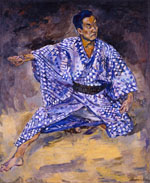
Portrait of Chojuro Kawarasaki, a Japanese Actor. 1928
He works much on the flowers: lilac, blossoming pear, roses, violets, lilies of the valley, orchids, the whole bouquets and even a garden in color.
“It is impossible to write a flower with simple brush-touches, ” so-so “, it should be studied, and deeply, as well as any thing else. Flowers are great teachers of artists: to understand completely a structure of a rose, it is necessary to work not less, than at studying a human face. There is everything in the flowers, that exists in the nature, though in more refined and complex forms, and it is necessary to make researches in each flower, and especially in a lilac or a bouquet of wild flowers, as in a whole wood thicket till you’ll be able to catch the logic of construction, deduce the laws of the combinations seeming casual… I write them as the musician plays his scales. After two hours of steady work something turns inside my mind and flowers become changed into sounds somehow… It is the grandest exercise for each painter “.
By Nikolsky …1936, p.112
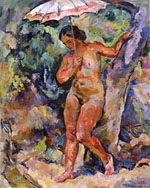
Girl under the Umbrella. 1929
In 1929 Konchalovsky writes a series of winter city landscapes.
In the summer of the same year he works in Crimea (Balaklava, Gurzuf),
writes such works, as “The Balcony with Grapes”,”Grapes on a Plate”, “Leaves of Tobacco”.
The artist estimates the trips to Caucasus and to Crimea, as the greatest events of his creative life for last years. He works much with water colors, aspiring to simplicity and ease of composition, tries to paint in oils, simulating water color techniques and opens in it the new textural opportunities.
“Having taken from the nature a casual to turn it into regular, – it is the original law of a composition in painting. We cannot search for a composition, sitting at home and running in fury around the room as Cezanne did when trying to put his still-lives. We are off from such way. We need to snatch out that string which leads to an original composition from the alive, untouched nature, it is necessary to accustom the eye to take at the first sight only that is necessary, from all heap of opportunities.. “
By Nikolsky …1936, p.113
At the same time the artist writes many still-lives among which the “still-lives of smoking accessories” prevail: the images of pipes, tobacco boxes, ashtrays, leaves of tobacco.
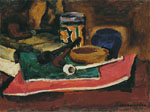
Still-Life. Pink Notebook and Pipes. 1929
|
In the summer of 193O, P.P. Konchalovsky works in Bakhchisarai and Semiz.
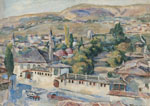
Bakhchisarai. General View. 1930
In Bakhchisarai he writes a series of landscape studies and does raw drafts and water color sketches for a genre picture “The Embroidery Branch of the First Collective of Weavers in Bakhchisarai” which writes after returning to Moscow.
A “rural” series of 1930 besides numerous landscapes includes images of domestic animals and birds. The works characteristic for this series are: “Hens”, “The Cock in a Basket”, “The Picture for Children”.
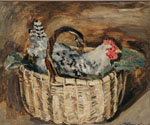
Cock in a Basket. 1930
In the same year he starts to write a portrait of A.S.Pushkin. Konchalovsky decides to represent the poet at the moment of his morning creative work, sitting on a green sofa in a shirt, having bent his naked legs in oriental manner. Preparing for the work on this picture, Konchalovsky makes some etudes of the naked female body on a background of a green sofa, studying parities of tones of a body and upholstery.
The work on the portrait proceeds all next year.
In the summer the artist lives in Barvikha near Moscow, then in the autumn goes to Leningrad and then to Ryazan where writes a series of landscapes.
The artist considers an oil etude – “Peter’s Small House in The Summer Garden” as one of the strongest things written in Leningrad.

Leningrad. Peter's Small House in The Summer Garden. 1931
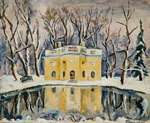
Peterhoff. Gentlemen's Bath-House. 1931
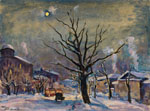
Landscape with a Moon. Bolshaya Sadovaya Street. 1931
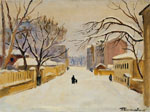
Moscow. Spiridonovka. 1931
In the winter of 1931, he writes two portraits: “The Portrait of Pianist Vladimir Vladimirovich Sofronitsky at a Grand Piano”, and a portrait Of a Japanise woman. In them the master solves the problem of a dynamic portrait.
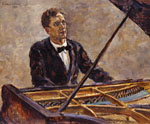
The Portrait of the Pianist V.V.Sofronitsky at a Grand Piano. 1932
In the winter of 1932 he gets a summer residence in Bugri (a part of Obninskys’ former manor «Belkino») near Maloyaroslavets, in the Kaluga area. There he writes series of landscapes, bouquets of flowers and blossoming gardens, still-lives, genre etudes, and etudes of a female body among a landscape. Since 1932 he begins writing a series of childhood-portraits of grand-daughter Katenka.
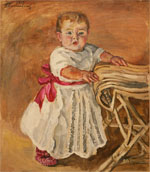
Katenka by the Chair. 1932
In the end of the year the artist carries out sketches of the scenery and the suits for Ferrari’s opera “Four despots” (Goldoni’s plot) for the Experimental Theatre in Moscow and for Goldoni’s comedy “The Mistress of Hotel” for MHAT.
“…For a long time I desired to return the real painting to the stage, whence it was so hastily expelled to be replaced with so-called designs, already boring and almost obsolete. It would be desirable to create the scenery extremely laconic, sparing of details, but achieve thus such laconism which can excellently be combined with the theatrical reality, and scenic properties. It is necessary to give the theatre such, widely written pictorial scenery with which would merge – “grow into the painting” all the suits and original subjects being on a stage. Such scenery is quite possible as an experience of “Four despots” has shown “.
By Nikolsky -…1936, p. 98
In 1932 he makes a trip to Leningrad to work on scenery for the State Academic Bolshoy Theatre.
In the autumn of 1933 he goes to Kutaisi. However the most part of the time since 1933 for 1935 the artist lives in Bugri where he writes the portraits of outstanding figures of Arts.
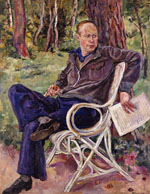
Portrait of S.Prokofiev. 1934
There have been written more than hundred portraits and among them those of S.S.Prokofiev, V.V.Sofronitsky, A.O.Stepanova, N.S.Golovanov, V.E.Mejerhold, A.N.Tolstoy, K.S.Simonov, V.G.Dulova, A.Dovzhenko, S.J.Marshak, B.N.Jakovlev, A.I.Hachaturjan, Z.A.Doluhanova, A.Korto, K.Zekki, Albert Sanchez, etc.
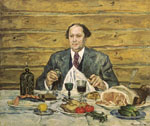
Portrait of A.N. Tolstoy. 1940
He continues his work on landscapes, images of bouquets of flowers, and blossoming gardens, still-lives and genre etudes.
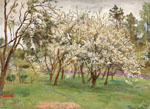
Garden in Bloom. 1935
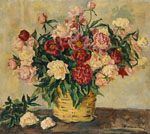
Peonies in a Basket. 1935
In 1937 he goes to Kirovsk and Apatity where also continues to write. In the autumn of this year he writes a still-life “Meat, Game and Brussels Sprouts”.
1938, Konchalovsky makes a trip to Khokhloma, writes a picture “The Female Sketchers of Khokhloma”.
The same year he writes Meierhold’s portrait at his home, on a sofa, on a background of a carpet.
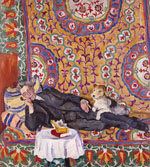
Portrait of V.E. Meyerhold. 1938
In the summer of 1938 he goes to Kislovodsk, where does a series of sketches of vintage and, in the winter, writes a picture, using this theme.
In 1939 the artist takes a trip with his son to Caucasus.
|
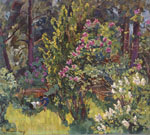
Children in the Garden. 1940
In 1940 the artist writes a series of portraits and, at last, finishes a picture “Pushkin” (he had been writing it for about 8 years).
With the beginning of the Second World War the artist with the family remains in Moscow, and since November, 1941 again comes back to work.
He writes Yumashev’s portrait, this work lasts till January, 1942.
The artist also creates pictures on themes actual for military years (a canvas “Where They render the Blood here?” 1941).
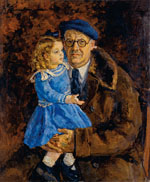
Self-Portrait with Granddaughter (Margot). 1943
1942-1943 M. Lermontov’s portrait is in work.
“While re-reading my Lermontov in a bombproof shelter, I was struck by the idea to write an image of our great poet-patriot. It was just the edition of my father. The memoirs had gushed over me. Being at Caucasus, I often imagined Lermontov at station Kazbek. So I had decided to represent him there and, having made the sketch, I begun to study his portraits, the life and the suits of that time. I had re-read all memoirs about him, and it had helped me to imagine the poet… In July, 1942 I had returned to Lermontov. I again began to re-read his biography, memoirs about him, searching for the brightest moments in his life for a picture.
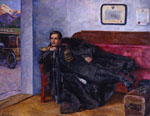
Lermontov. 1943
I searched for Lermontov’s image in the portraits written from life, in memoirs of contemporaries and, at last, in his poetry. In exile Lermontov has written the remarkable poem “Kazbek” expressing his alarm, his melancholy. Lermontov should appear in my picture almost a boy, proud and happy of recognition, but homesick,.
I have finished “Lermontov” in April, 1943. “
The Curriculum Vitae – p. 5-6.
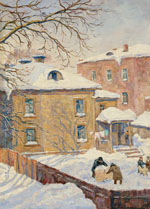
Spring. Small Yard. 1942
During the war, he also writes three Moscow spring landscapes, three lilacs, three bouquets, two self-portraits, L.I.Tolstaia’s and S.N.Troinitsky’s portraits.
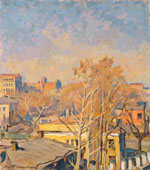
Spring in Moscow. Konushkovskaya Street. 1943
In 1944 the artist carries out sketches and scenery to Bize’s opera “Carmen” for the State Academic Bolshoy Theatre. The work proceeds till 1945.
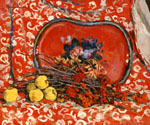
Still Life. Red Tray and Rowan. 1947
In 1946 he writes a still-life “Oranges and crumpled paper “, devoting this work to P.P.Chistiakov, and creates a conversation – “The Floor Polisher”, written in the exact, confident pictorial manner.
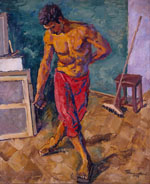
Floor-polisher. 1946
During the second half of 40th years, Konchalovsky writes a plenty of portraits, often of chamber character.
It is possible to note a portrait of surgeon A.A.Vishnevsky (1951) or a long number of portraits of grandsons of the artist, such, for example, as pictures: “Margot dances” (1949), “Andron with a Dog” (1949), “Margot with a Cat” (1948).
He writes also numerous landscapes, pictures concerning to the post-war years with the image of a national life on a background of Russian nature (“After a Mowing” 1948, “Rowing the Hay” 1947,), still-lives (“Field Flowers on a Background of Green Jalousie”, “The Dog Rose on a background of the white tile Oven” , “Wine and Ham”, a long number of “Lilacs”).
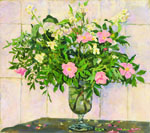
Jasmine and Dog-rose near the Oven. 1953
With works of this period the artist summarizes his creative experience, aspires to the synthesis in painting and again starts to write great canvas.
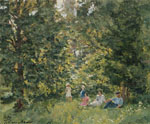
Under the Trees. 1954
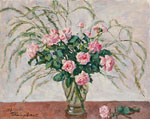
Rosettes and Asparagus. 1955
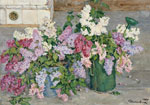
Still-Life. Lilac, Bucket and Watering-can. 1955
In the introductory clause to the catalogue accompanying the Fifteenth personal exhibition of Konchalovsky (1951), Vsevolod Ivanov sums up the previous years of the creativity of the artist: ” Konchalovsky’s creativity has really developed today, and the previous years were only the approach to his present triumph… Konchalovsky’s paints are bright, and in his pictures there is a lot of sun and air, his coloring is unusually juicy, he shows subjects boldly, convexly… P.P.Konchalovsky’s XV anniversary exhibition is an enormous victory of the artist.
To this victory the artist has come, having followed the road of the real sincere serving the people by his art. The author of compositions, the landscape writer, the portraitist, the theatrical artist, the master of still-lives, painting porcelain utensils and samples of tin-plate trays, – everywhere he is the big artist. He loves the life and in the life most of all he is enamored in art… He is the worker regretting every evening, that the day has terminated, “and the hand is not tired yet “; The refined judge of another’s’ works. He is pleased to the occurrence of a new talent and in every possible way helps to promotion of this talent. He is the public figure hotly loving the Soviet native Land and its successes in all areas of the life. Such is Konchalovsky – the singer of flowers, and the sun light “.
|
The artist’s thoughts presented in this section were written in 1930s by an art critic V. Nikolsky and published in his book “Petr Konchalovsky”. Vsekohydojnik. М., 1936.
-My own painting was clearly shown to me by the creations of Van Gogh. I have felt finely that I don’t stumble at the same place any more, but am going steadily forward; now I knew how a painter has to treat the Nature. I have not to copy the Nature, not to imitate it blindly, but to search the characteristic and even change the visible appearance without hesitation if such is the demand of my artistic view and emotional will.
It was Van Gogh who taught me to do as his own words go “do what you are doing in accordance to the nature”, and there was a great pleasure in it…-
-It seems to me, Van Gogh and Cezanne do not contradict each other. Their creativities rush by the same channel, they are close in the face of the nature because both of them are descendants and continuers of great Monet.
Really, at due analysis of my «Palm Trees» of 1908, written in Sainte Maxim, there probably would be found, nearly indisputable elements of Van Gogh, and “pieces” from Cezanne, because so I have seen these pieces in a nature and so I should transfer them.
You can find the influence of both these masters, for example, in Matisse’s painting; the decorative elements there have come from Van Gogh, and the generalizations, synthesis – from Cezanne. However it is possible to find the influence of Van Gogh as well at Picasso and at Derenne, and at many other French artists.
At Cezanne, the method of understanding the nature was dear to me. I followed it still even in my more mature years because Cezanne’s methods enabled me to see the nature in a new fashion. And I always wish to be true to the nature…-
-I instinctively understood even at those years that without some new method there is no salvation – it is impossible to find the way to the real art. That’s why I have grasped at Cezanne as a drowning one would grasp at straws.-
-Till then (the trip to Spain at 1910) I knew some not quite natural, “Italian” Velasquez, but in the “Tapestry Factory” and other things at Prado I saw a real Spanish painter: not only by its colors as in the portrait of the papa Innocentiy in Hermitage, but cold, gloomy.
How striking are the shades of light blue, mouse-grey, or black of the Spanish masters! As for me, all Spain was drenched with colors of these old painters. I was so excited by them that when we were at Escurial, I had passed by the wonderful, colorful tapestries of Goya and did not estimate them as it was due…I wish I could go to Spain now to have a look at them.-
-Initially I have written «The Bullfight» (1910) absolutely realistic, Surikov considered this thing remarkable by vitality of its expression, but I did not like it. I desired to make the bull more typical, not just an animal, as everyone can see it, but similar to a toy in its primitiveness. I always loved folk art – those toy-makers of Troitsk which are carving of wood the “bears and the muzhiks” for all theirs life. With fair simplicity and force they transfer the essence of an animal and the person, using the most elementary means, reducing all to the two-three most characteristic details. I desired to give the fighting bull the same “toy”, “muzhik” simplicity. I wanted it to seem like an awful toy, or even more – a “devil” as it was represented in Middle Ages in churches. So I have rewritten it. I remember, Surikov had considered, that I was mistaken and regretted the former bull, but I liked this new one, more. -
-The nature of France and Italy is always filled with air and transparency; colors frequently fade there in a kind of foggy veil. As I have told, it is quite on the contrary in Spain – the colors are terribly simplified there: the black and white colors are dominating all other, as if every other color were strewed by their ashes. Spain is a poem of black and white colors for me, so I have felt it, and I surely had to paint it as I felt. All the time till I lived in Spain I was chased by thought to learn the art of simplified, synthetic color.
That was the task I worked on in the portrait of my wife and children of 1911 (“The Family Portrait” 1911).
Two colors are dominating there in the Spanish manner: black and white. The red and green – though strongly given in a portrait – are playing strictly subordinated role and their aim is only to emphasize sonority of two basic tones of a portrait. The Chinese picture entered into a background serves as accompaniment to these basic tones. It repeats again the black (grey), and reflected tones of red (pink gills of a fish) and green (a bluish-green wave). At closer examination of this portrait, there would be already found some first sensations of materiality of subjects, and beginning of “constructivism.-
-We all were united then (1910 – K.F.), by the filing of necessity to rush against the old painting. The painting we wanted had to be close to the frescoes of the Middle Ages by the style, we recalled Giotto, Castagna, Orcagna and other old masters. It was a period of “storm and impact” for us, as at the rush of “romanticists”. We considered that a theme, whatever it would be in reality, becomes “acute” for sure if it was made acutely. It was necessary to achieve this acuteness of painting. But we also knew that the most acute theme becomes nothing if the painting is bad. We were considering then that it is necessary to master the language of painting first and then anything, whatever a painter choused, would appear magnificent being painted magnificently. In a real masterpiece of art “what” and “how” are inseparably grown into each other. The concept, the idea of the thing has to prompt to the painter the method of its realization. -
-Since the time of its foundation our group had no intention to “shock” the bourgeois, as they say now. We didn’t think then but about the painting, the tasks we had to resolve. The “Ideology” had come later, when after the division at 1912 – 1913, the “Jack of the Diamonds” began conducting the disputes at the Polytechnic Museum and the “futurists” had joined our group. The matter is that at the very foundation of “Jack of Diamonds” our attitudes to the art were different. The splendid artistic gifts of Larionov and Goncharova surely made them our allies, but there were great differences in our attitudes to the art: Mashkov, Kuprin, Lentulov and me – we were devoted to the painting with a kind of youthful passion and thoughtlessness, with the uttermost disinterest in financial sense. And the Larionov’s group even then already dreamed of glory, popularity, they wanted the sensation, the scandal. That is why the split among us had occurred so quickly: after they had left the “Jack of Diamonds”, Larionov, Goncharova and others formed more “left” association – “The Donkey Tail”. -
-It is often said about the “revolutionism” of the “Jack of Diamonds”, but this word, I think, confuses all because it has a certain political sense. We certainly did not think of revolution in political sense at that time. We thought we are doing only the revolution in the painting. There were, certainly, lots of youthful inclinations, extremes, but all of them have passed, and remained only what was valuable, necessary, that we tried to achieve – the good painting.
Now we are accused for absence of the thematic, but they cannot deny the quality of our painting, and that is the essence, for without of high quality there is no real painting at all, and especially – the thematic painting. That is my point of view. -
-I wrote Yakulov’s portrait (“Portrait of artist Yakulov Georgy Bogdanovich”1910) being in a kind of victorious mood, I felt myself to be so strong in painting after Spain. In this portrait, in the most open, barefaced form, I wished to oppose prettiness and smoothness, beloved by many artists, with “something” that is considered ugly in the general opinion, but actually is extremely beautiful. I wished to show the beauty and picturesque power of this imaginary “ugliness”, to show the essence of Yakulov’s character. Benua had learned somehow about this portrait, arrived to my studio and had persuaded to show the portrait at the nearest exhibition of «The World of Art» before it will be exposed in «The Jack of Diamonds». I had brought the portrait to the exhibition, but it appeared very difficult to find a place for it: the perspective of neighborhood of such a «scarecrow» frightened all the painters. I said – “Hang it up wherever you want. I don’t care.” There was Serov at the exhibition, but his attitude towards me had grown cold at some certain moment and he liked the painting of Mashkov better. Serov smiled and said – “Well, you may care it not, and what about the others?” I had lost my temper and asked him directly – “Do you like it, Valentine Alexandrovich?” And I remember that I was surprised with the sincerity of his answer – “Yes, I do. I like it very much.” I was astonished even more because Ostroukhov, who also was there, being asked the same question had maliciously hissed eyeing me through the glasses – “Yes, I like it.” But the newspaper critics, certainly, were of absolutely other opinion: they named my “Yakulov” “a victim of a car crush”. One “witty” off the spectators had directly written under the portrait on the wall – “fool”. It all was so frankly and simply then. -
-I have noticed in Siena (1912) that people sometimes are taking sit in the Italian room for some reason as if they pose for a fresco. The life itself has suggested to me this circular, fresco construction for the portrait made in Siena (“A family portrait” 1912). The circularity of composition, its spatiality is precisely emphasized here by a door with a ladder behind my wife, in the highest point of the semicircle. That monumentality of composition of the portrait is also given by Siena. In the color decision I kept to the primitive simplified tones. All is immensely simplified in frescoes as well, though the images represented in them quite often seem absolutely alive.
I remember how I was pleased by a small “discovery” made in the portrait in Siena: ones, I have casually put a chair in front of the canvas which stood on the floor, at a wall, and it has appeared, that a chair simply “grown” into the picture, merged with it, despite the simplified nature of forms of the picture. I have tried to put other things in front of the portrait – the same effect, and they merged with canvas. So the secret of the “real” painting, by its qualities opposite to the naturalistic illusiveness, had been opened for me. This “secret” gave me the new strength and new courage, showing me new qualities of the painting which were far from impressionism. -
-The problem of labels had become just the chasing one for me after that occurrence with a chair in Siena. The matter is that any label entered into a work of art, forces the painter to raise the painting tone terribly, to achieve its uttermost reality, working with the synthesis of the color only, having absolutely switched off any emotion of the painter, any pictorial environment.
Well, I made those labels out off the pleasure to argue the reality, to achieve a tangible transfer of the real existence of subjects, without falling into extreme margins of naturalism; by no means was it done for the amazement of the spectators. I needed it only for myself, for my art, without it I could not move forward. That is the matter. And I did not think of the spectators at all at that period. -
-That (the cubism) I needed for to seize completely the art of extracting out of nature the most characteristic, essential, to learn arranging a composition and finally to be quit with the traditions of pictorial naturalism. I knew in advance that I should be cursed, and nevertheless I went on exhibitions. I did so because it was interesting to learn the opinion and estimation of colleagues – the explorers as myself and of the people acutely feeling the painting. It was necessary to suffer all the rest patiently. -
-Valloton had noticed very acutely the national, “Slavic” character of my painting, which then had a reputation of pure French in Moscow. And certainly it could not be otherwise: I could be considered a “Frenchman” only in accordance to the Moscow point of view. Real Frenchmen understand me because I am working using French methods of painting, but I will always remain a Slav for them and even “barbarian” on the colour, as the French critics wrote. -
-As I consider, the Barbisonians are, in essence, a branch of Old Dutch landscape painting. In the famous “Road in Middel-Garnis” by Hobbem at London Gallery all Barbisonian School is already represented. But Barbisonian painting is more acute then that of Dutch for they developed only one branch of the comprehensive Dutch landscape. And we, the modern landscape writers develop even smaller part of the landscape then Barbisonians did, because we are the analysts, we toil our own road and use our own methods. -
-The “Samovar” which is in Paris, I consider the strongest of my still lives of that year. I have resolved a very special problem in it. Any shine can be transferred by two ways in painting: either by gradation of the treatment of light and shade, or by decomposition on the plane of all color shades of a shining subject. The task is not easy but if I managed logically enough to compose all shades of colors, the impression of metal, glass or anything else shining that is wanted would be well transferred. There would not be any illusion, any deceit, but the reality of the subject would be plainly seen.
I was absorbed by it then, and that was the reason that I liked writing metal, crystal or porcelain. I dreamed even to write some jewel having decomposed it on the plane. -
-I definitely would like then (in “Agaves” 1916), to process carefully the surface of a canvas. The value of the texture in painting was, certainly, clear to me ever before. I always admired, for example, Renoir’s texture, and the texture of Titian even was specially studied, but the problems of the kind were not arisen yet because there were other, more essential problems. The care of the texture can arise for an artist only when its painting manner has already ripened, and as to me, it had occurred only in 1916.
I especially carefully prepared the canvas for “Agaves”, and aspired in painting, that the texture of the surface would transfer external properties of subjects: chalky whiteness of a paper leaf, leaves of an agaves filled with juice up to resilience, oiliness of the polished wood. The technique of the painting here also was extraordinary to me: I wrote on semidry, ran to the lessenings, used a lot of varnish. But after “Agaves” I almost could not get off of the questions of texture, whatever I wrote. The care of a surface became one of components of my manner. -
-The greatest and most valuable thing in a work of art is its conception. If the time for realization of the conception is lost – all is lost. Pushkin often said that sometimes it happened to him that there had been born some finest idea for the poetry but there was no opportunity to write it down and it faded away. The realization of a conception has absolutely logical nature and is to be fulfilled in the due moment, or never. The moment is dropped – there is no product or it is spoiled, “cooled”…
There are some who think that I work hastily and write too much to the detriment of myself. It’s a mistake. I write much just because I have lots of artistic ideas, because they are born continuously and demand the realization and after all I have no employment but the painting. I hurry up only when I feel that the moment has come for realization of the idea. Then, for sure, there can be no delay. Many a time I have proved it by experience: if there were any delay, I always remained in loss as an artist. That is why if only I feel that I may be late, miss the moment, I have to leave all other things even if I had a desire to go to the premiere at the theater or a concert or anywhere else. I am sure that any artist has to act so. An artist has to get accustomed to leave everything for the sake of the painting, to be ruthless in this sense. That is why I could not work as it is due, as I need and as I have got used to, when I was at the military service and during my professorship. The painting as a hobby is not art. -
-By the end of the military service I had instinctively felt that the ways in painting I had planned to explore, had already been passed by and left behind, and now it was time to search for some others – new ones. It seemed that close dialog with the Nature would show this new way, and with this hope we went to Crimea for the first time in our lives. The nature of Crimea in its pictorial aspect was absolutely dim for me, but I hoped to conquer it as I had conquered the seaside nature of the South of France – by the emotional effort of the will and on the basis of available and well-tried pictorial methods of impression. But Crimea had not let me in, was not perceived, did not keep within my schemes. It became quite clear, that the methods of painting already learned up were not sufficient. It confused me when I firstly realized the problem, but having thought it all over, I came to conclusion that it could not be otherwise.
While an artist works out of Nature, his impressions are fresh, interesting, his painting is new and significant. But as soon as he approaches the Nature haughtily, feeling as if he is a conqueror, ennobling himself above the Nature, then the Art dies.
So it happened with me: the painful but very useful lesson I have received from Crimea. Having returned from there and being finely quit with the military uniform, I nestled to the Nature as a diligent pupil and then the Crimean feeling of a deadlock had quickly disappeared. -
-While learning the art of Great Old Masters at the museums and art galleries, I always was stricken by the extraordinary vitality of their expression. Sometimes, looking at an image of a feast, say of Verona school, with its crowd blossoming with the colors of attires; it seems to be alive in such a degree that almost moves on the canvas. Then one looks at the monocolored, dim figures of the visitors and is amazed: they are the same people, the same crowd that is on the canvas. The bounds between the Nature and its image are erased. The achievement of such force of impression in the painting is the most difficult problem and a goal of each painter. That is my “credo”.
And in that portrait (“A Family Portrait” of 1917) while drawing my daughter’s figure I felt like throwing a challenge to the life itself. Another matter is how much I succeed in it, but that was what I wanted. I enjoyed the feeling that I am plaiting a real plait of the living person when I wrote a plait of my daughter in the portrait. Enjoyed the thought that by means of the nut-color paint it is possible to braid quite real plait, to braid it so, that living hair will be felt in it of the person alive… Such work gives an artist the happiest minutes in his life. The realization that a human life is placed among other subjects is a feeling of cosmic nature, and ones being achieved, it is difficult to be forgotten. -
-The “Violinist” (portrait of the violinist Romashkov of 1918) had seemed to me staying apart of the general course of my painting, something quite unusual. Until then, I was quite absorbed with the substantial appearance of the nature, its “flesh”, but while I worked over my “Violinist” it was for me even disgusting to think of flesh, bones, a human skeleton; I had desired so much it all to be inspired, free of substance and terrestrial flesh. I don’t know, whether so it was actually, but it seems to me that this inspiration came due to music, due to its marvelous mathematics and logic with which Bach is so strong. The mathematics of Bach took a grasp on me and carried me away to some spiritual rise, under influence of which, it seems that the artist works absolutely unconsciously, without knowing how it all goes, but in reality, those are the moments when the artist possess improbably clear consciousness of what he should do.
Clearly feeling the mathematics and geometry in Bach’s music I wished to construct the portrait as a kind of geometrical figure. Musical sounds somehow transformed themselves into the painted planes on a canvas; the most insignificant musical hints opened the deepest truths of painting …But I was not in euphoria during the work; on the contrary, there was cold and clear consciousness of what I would have done, I had quite certain purposes and worked fearlessly.
It is not easy to believe, but the “Violinist” had been written during one session. I saw perfectly that the thing is not “made”, not finished, even on the canvas were places which had not been covered with the paints, but it seemed to me that the picture already gives to the spectator all impression that was needed, so I decided to stop the work. To say the truth, I was terrified to continue writing at a thought that the inspiration already achieved could suffer if the painting were more complete, that the painting could take the better on impression. Now, recollecting how fast and fearless I had worked over this portrait, I feel quite sure that, in aspect of creativity, it is mature, finished and does not need any amendments or additions.
Working over this portrait I have received a new lesson of art of treating the nature: when one simply draws from life, he generally does only muscular, physiological efforts, but trying to comprehend the nature as a kind of mathematical formula and transfer it so, one gets to the impression infinitely alive, strongly exiting both an artist and a spectator…-
-I noticed that I have certain similarities in receptions of music and nature, so closely they are combined in my soul. It happens sometimes that hearing the music effects in me the new pictorial conceptions amazingly logical, bright, and full of beauty. For me the musical phrase, especially when it belongs to Bach, emphasizes the nature. And it’s due to the Bach’s mathematics that I wish to be rather economical in the means of pictorial expression. The achievement of the pure simplicity, so necessary to the real art, comes only through that mathematics. This process is subconscious and I cannot tell you about it but nevertheless it is so. And in the real art it couldn’t be otherwise. -
-In my Abramtzevo oaks there is still, certainly, a coherence of painting to Cezanne’s methods, which I have got used to work with and to which I felt the relationship. But my attitude to the nature now was another. Passionate was my desire to create a living landscape, in which the trees would not stick up being simply stuck into the ground, as it often should be seen in modern painting, but logically grow from the depths of the ground, as those of old masters. The spectator could feel their roots. And for this purpose it was necessary first of all to construct logically each tree, as they construct the building, from the base up to the roof, from the roots, which had deeply grown into the ground up to the foliage of tops. And I was surprised very much ones when I learned that the buildings have “roots” too: the well known to me tower in Siena has its “roots” protecting it from the earthquakes. Before I had started working, had finely defined the place, I wandered for long all through the grove, watching and learning the details. Learning the details I didn’t mean to transfer them all onto the canvas but to comprehend the logic of structure of branches and trunks, to see a composition in their “mess”, as Alexander Ivanov in his time managed to comprehend the Italian olive trees, making a kind of phenomenal “noodles” out of them, though quite true to the nature. I had to find a rhythm in this mess, to overhear and fix in the mathematical forms the melody of this imaginary mess, but I had as well to keep strictly the accuracy of proportions. Let me again to refer to Ivanov: the leaves in his etudes – in his olive trees for example – are always given in true proportion to the trunks, such was his skill of seeing the things… The most important in a wood landscape for me is a silhouette of a tree against the sky, a silhouette of its branches. Old great masters could perfectly do such things, but imitators have turned the fine method into a “trick” of craft and I was forced against my will to go through the nature to classics as Cezanne taught. -
-Buy the way; I’d like to say on the methods – technique of painting. All of us – artists, certainly are formal to a certain degree, but there is a formality of highest quality of painting, formality showing skill and resource of an artist, and there is another kind of formality – the mere “trick”, pictorial “chatter” of bad taste. A real method, skillfully found in the nature is such formality, which makes a spectator to submit, even if he sees and feels that formality. And an acute spectator will always feel the “tricks” and well define their force, which is rejecting the art.
A real “technique” is a stroke of brush completely and precisely expressing the form, but if there were any mistake in it, then instead of the technique we get a bad formality, just nothing… It is possible to say – and some says – It is pure “formalism”. But it is not correct; “formalism” is not there. Any healthy substance may be turn to a malady, being overused or used without skill. There, surely, is no painting without perfect forms, without high formal qualities of a product of art. However, if a callous transfer of a form is the only purpose of ones painting, then it is a bad painting, it is an abusing the form, it is a real “formalism”, more (at the best) a school exercise then a work of art. But if the form in the painting serves as a means of expression of an artistic emotion, of a certain contents, of an inspirited plan of an artist, then is it possible to deny the necessity of the most careful studying and uttermost possession of such form? -
-The formal side of Suricov’s creativity was very strong – if you need an example, and is he not an inspired master whose works are filled with psychological contents? But the “formalism” as a skill of seeing and seizing the form was improbably strong at him. He is enormous as a master in his highest displays. And his grander is due to the possession of the form, to the deepest knowledge of it. Surikov loved dearly that pictorial naturalism in art, which is so strong expressed at the Old Masters, especially at Raphael, where it gets to the great refinement, even to admiration for the form. At Raphael you will not find the attributes of monotony as at Rubens for example. Rubens was not so sharp-sighted; he was not able to track out the pure truth. And an artist, after all, has to take of nature only the pure truth. It is due to see not only an appearance, but the phenomena itself, to comprehend the essential. It is a pleasure to write from life when one has seen and understood the real forms of the nature. Rafael was immensely strong in comprehension and fixing the forms.
The same is in other branches; Pushkin had an enormously strong feeling of a form; all is so perfectly made, the form and the contents are undividedly united at him. This – what a real, great, complete Art is; the form and contents there are always merged.-
-Let us turn back to the Abramtzevo grove. The conception of a landscape took its beginning from downward – from the roots, or from upward – from the tops of trees. The basic, leading masses of colors were all thoroughly tracked down, especially in autumn landscapes, there it is necessary to find the brightest, leading spot or it would be impossible to construct the landscape. The essence in the painting, as well as in any other art, is in the selection. It is possible to write a wood so that all trunks and branches of trees will be seen there, but it may as well be shown in great plans, to give only one trunk, only one branch, but a spectator will see a whole wood. The things shown too close to the nature sometimes are not similar to it absolutely. Surikov often said – “It is necessary to sacrifice such a lot of details!”
One should not take all he sees, it is necessary to generalize and select. Tolstoy reasonably said – “They take for a work of art only what is going down the fur, what is going against the fur, is to be thrown away.” The “fur” here is, of course an artistic conception, which manages all process of selection. -
-The intimacy of landscape being not expressed in mature forms is, in my opinion just a cheap trick, and at my earlier years I was afraid of it. It could deform the very method of seeing the nature, turn me away from the true ways. But now I felt strong enough to express even my intimate conception in pictorial forms, which I considered true, original and capable to be filled with contents… The word “contents” for us – artists, has to mean, first of all the pictorial contents, pictorial sense of a product. An artist is the one who can explore the world and there, in this endless cosmos, can find something new, investigate and express it. And this very discovery constitutes the contents. -
-“Portrait” is very complex and diverse kind of painting. But the matter here is what an artist chooses: psychology or an artistic image, the last should mean an absolutely indissoluble connection of psychology and pictorial form, such connection where psychology quite merges with the form. The modern portrait contains a great deal of psychological expression. Such are the portraits made by Repin, Serov, Tzorn…. But the creativity of Old Masters is filled with the artistic images mainly; we see such expression at Titian, Raphael and so on. The artistic image certainly, must be quite realistic, but never naturalistic. As an example let us take a human body depicted by Titian. It lives its own, particular life, because the artist does not follow the nature slavishly; he generalizes the forms, as it is needed, sees, perhaps, the whole humanity in one human being, as the ancient Hellenic sculptors saw it. It is from their marbles, that the forms come of the Venuses and Diana by Titian. And in my opinion, it should constitute the main goal of the art, even of completely thematic art. A theme would rise above a mere illustration and get a long-lasting value if an artist could find the high artistic images for it, if he could distinguish, like Shakespeare did, the eternally human among temporary and passing…
I generally don’t like representing a person in his domestic life in a portrait, but I always aspire to distinguish his personal style, and to find there some universally human traits, because I don’t care for the external similarity – I care for artistry of an image. It is universally human, that I search in originals of my portraits. And in this search I have my support in creativity of great masters of Renaissance who were able to create eternally attractive portraits of absolutely unknown to us people. Surikov said not without reason – One can find the Greek beauty even in a skeleton. And this beauty we have to search in a portrait if we understand it as a work of art, not as a mere recollection about a person, being told in the language of painting. -
- Certainly, form and color exist everywhere under the same rules, but it does not mean that in the painting it is possible to estimate a human being as some subject for a still life: say a bottle etc. And it is very strange to me to hear the charges that my portraits are similar to the still lives. My portraits may be imperfect, even bad as a painting, but it does not come from my present attitude to a person from the point of view of “subject being” of all in the nature. It had ended in 1918, when I wrote my “Violinist”. In the portraits written before that, indeed, I searched the likeness to the still life, “subject being”, because I searched it everywhere then. But as to the portraits written after revolution, such charge is unreasonable, radically contradict my understanding of the art of painting. If I were accused of absence of “Serov’s” psychological, searches of character of a person, it would be true, and I should accept such charge…-
- The portrait of 1923 (“The Portrait of Artist and his Wife” 1923, – K. F.) I had been thinking about, and then writing, for a very long time. It would be desirable, that there were no brightness of paints in it, that it all were sated with tones and treatment of light and shades. This time I wanted not “to do” a subject, not to transfer the attributes of its “substantial being”, but “to write” it, to insert a subject into its environment in the picture. The composition was arranged with difficulty, especially the position of hands, and it took a long time until finely they were settled down similarly to an “eight”. By chance, my own face was written at once, but I was forced to work long on the image of my wife. As the entire portrait should have a uniform color decision, my wife had put on a special dress, made by my design: a black velvet corsage and sleeves of the color of bronze. The velvet was written in a complex composition of many paints, up to Indian yellow. And in general I have worked a lot on processing the texture of this canvas, much more, than in “Agaves”. There were the dangerous moments during the work: written before was almost spoiled, sometimes I was forced to drop the work, to doubt the future and my forces, my ability to master the problem… This portrait had taken much, too much! -
- I painted from Tintoretto as from nature (during a stay in Italy at 1924) and only then I had understood how immensely full of life his painting is in its every piece. I recollect how I was stricken with the figures of warriors playing dice, in his “Golgotha”. And I had made a quick sketch of the structure of this group. Later, quite accidentally, I had seen the sketch of Tintoretto to this group, among his drawings, and I blushed with pleasure that I had luck to guess an artistic conception of this incomparable master. -
The author had been excited with the nature during his stay in Sorrento at 1924.
- Such moments are always for good to ones soul, though I don’t consider them so very profitable for the development of personal creativity of an artist. It was for me the time of somnolence and dreams after deep spiritual worries of the war and revolution, time of the spiritual rise leaving its trace in all further work, charging for the years with joy and vivacity. But an artist cannot breathe rarefied air of such heights for long – he has got used to work in a valley, he always needs the uttermost internal balance for real advance, and here the balance was surely lost. -
- I left Venice with sadness (1924). It had been wrote by so many painters, saying nothing but of ancient times: Carpaccio, Gentille, Bellini, Bassano, Longhi, Canaletto, Guardi, Belloto, and each of them had Venice of his own, and all of them had depicted true Venice. I do regret now that during that time I was grasped by the current of some “thoughtless” painting, and did not put to myself any problems of analytical order. Though we had been to Venice not for long then, I could catch nevertheless a particle of its soul….But yes; it was a happy travel, full of pleasures. -
- All the works that I had brought had a success and were favored by public, but they did not satisfy me. They would be stronger if I were not so captured, enslaved by perfect beauty of all that is visible. Though, this “capture” had warmed my painting, sated it with emotions, still I don’t like, that while writing these pictures, I didn’t quite possess myself, and I think, it is bad for an artist. When an artist loses self-control during the work, the quality of his painting decreases, because the most important part of the art of any artist – the search of ones own style – disappears. In my pre-war works I am full of extremes, I am hyperbolic sometimes, but all of these comes just because then I searched my style in rigidity, roughness and in simplicity. My favorite great writers all are stylists and masters of the greatest simplicity – Shakespeare, Goethe, Pushkin, Byron… -
- Certainly, if an artist wishes to get a cheap popularity, he should go to compromises to the tastes of the consumers. I find such compromises at many; for example, I see them at Tchaikovsky. But there are no such compromises at Bach or Beethoven; they did not need them because they were giants in art. You will not find such compromises at Shakespeare or at great masters of Renaissance because they possessed really high style.
And what about us – it is another matter. We have to watch our mistakes constantly and sharp-sightedly and especially the mistakes on decrease of the quality of painting to naturalism. It is necessary to correct these mistakes constantly, not to forget ones place… Sometimes I curse myself that I lose self-control and the nature takes better on me. Then I write as I did in Italy – naturalistic. My Italian works are sinking. And such things happen almost any time I fall in love with nature too much. Though it gives artist fame, popularity, makes him related with the spectators – all is welcome and even necessary –but all this is not to be bought for the price too high, if one loves the art. In fact it means eventually, to deform the beauty of nature, to substitute the eternal in it for passing, to feed a spectator with boiled down food as a sick person. At all my temperament, there lives a great internal steadiness in me, and consequently I wish to be “boiling” only at the moment of perception, but by all means to get “frozen” during the creative embodiment… That is the reason that I still love my pre-war painting, the painting of times of the intense searches. Certainly, I know but too well that these things are far from perfection, because they yet don’t express all my desires and all my artistic will. And to the Italian works of 1924 I am rather cold, because there is no my artistic will in them at all. -
- Leaving Paris (1925), I had had a little bit frightening notice – the painting of some French artists had somehow degraded after the year of 1908, compromising to the consumers’ tastes. But French masters have managed even at this decrease to keep the stylistic qualities of their painting, and I have absolutely lost them in Italy. The example of the French artists showed, that the interests of public could be observed even without serious losses for stylistic features of painting. But I was not able to this then, that is why there was no other decision except for return to the analytical painting, to try working with the same cold consciousness with which a surgeon carries out an operation, ruthlessly rejecting everything “entertaining”, superfluous, which often turns the painters off their way and, among them, I am not an exception. -
- What had happened to me at my first arrival to Novgorod (1925) was just a repetition of the Italian case. Here again I was defeated by the nature to such degree that I almost lost that special state of mind, which is absolutely necessary at work. I almost didn’t know our country, was in so a little degree interested with it before! Well, the more I was impressed with it now, with its special warmth, original, quite Russian beauty. This “capture”, surely had effected in my painting. The late Lunacharsky had written very reasonable that my Novgorod “buildings” are real “creatures alive”. But it sounded for me not at all as praise – more likely it was a reprimand of my pliability, reproach for my withdrawal from the positions of real painting. But I had no strength to resist. At all their stylization and formality, the church Novgorod frescoes stunned with their vitality and native color-scale. There were repeated all circumstances of Siena: one comes to Novgorod church at some market place and sees around him the same “prelates”, the same faces, sometimes even the same expressions…It was so exciting that I had written then a large canvas of genre – “Novgorodians”. There was an old Russian tavern in the “Buianova” street in Novgorod, I wrote “Novgorodians” there at the hours when the tavern was locked. And I could not help “overloading” the canvas, because picturesque charm of the subject heavily fell on me and eclipsed my artistic consciousness…
Only at the termination of our stay in Novgorod my consciousness began to clear up little by little, but it already was time to think about departure. However I had decided firmly to return there again next summer…. -
- It was spoken a lot about this portrait (“Portrait of N. P. Konchalovskaia, – the artist’s daughter” 1925 – K. F.), they even mentioned Natasha Rostova of the “War and Peace” by Leo Tolstoy, though I was quite absorbed by one thought while working – to transfer the shine of the silk the better, and I thought of nothing else…
There are such moments in artist’s life when it seems that something new is already found, but when the work has been started, one sees that there’s nothing found at all. But sometimes it happens that, on the contrary – one thinks he is working on the problem and is far from its decision, but the work appears to be quite complete…
The ways of art creativity but too little and poorly are known to us. -
- In the «Returning from the Fair» 1926 –(K. F.) I had a conception to impregnate with movement all: the sky with running clouds; the smooth surface of the lake cut around by sailing vessels; the running horses, and the movement of a cart. My desire to transfer real dynamics was so strong that, I even ran near a rushing cart to catch a notion how horse’s legs are settling onto the ground during the run. I have done a special etude of a shaft to seize its line more truly, though I have a good art memory. The theme grasped me so that I couldn’t help falling into absolutely unnecessary naturalism: I even tried to depict the dust from under the wheels for example, where I had only to take the wheels in the essence of their movement so that the spectator could see how they are raising the dust. In the real painting, as well as in any real art, there always should be an innuendo, some work should be given for the eyes and brain of a spectator, or it will be boring; instead of a work of art there will be a report. But I have forgotten all of this during the work, and I was taken too much by the faces, and by the cart, and the harness. And as a result I didn’t get the purpose, was absolutely beaten off from fresco style.
I am reproached for absence of a theme, but it is not less bad when a theme too heavily leans and crushes under its weight the painter. One should keep a devilish balance inside to do the real painting. -
- I had not even the least intension of course, to glorify the monasticism (“At Yuri Cathedral” – 1926), which I was reproached for. In this case I was just strongly interested by human “duality” – that great change which is made in the image of a person by fulfillment of a work he is in. I had been interested by it since my “Violinist” of 1918, though I had shown there only one side – Romashkov transformed by music, – the second part of the task – Romashkov apart of music, – Konenkov had fulfilled in his sculpture instead of me. Now, being attracted by picturesqueness of conditions, I have decided to show both aspects of this person I had observed. It was especially tempting that being clothed in forms various and very interesting for painting, they demanded absolutely different approaches, special flexibility. -
- As every thing that I write, I begin a landscape with a sketch, sometimes even with several of them. When I see a piece of nature interesting for me, I see the whole thing at once; I see and feel how I should “arrange” a landscape. I never could just “take” what I saw, acting as a photographer; there is no art without composition – it would be a naked naturalism then, which I consider the sworn enemy of art, the most infectious malady of it. The primary perception of the nature inevitably includes my reflections on the pictorial impression, which should be given by that landscape. The process of overcoming of the reality, comprehension of all that is casual and impeding begins at that moment, and there starts that concentration of the visible which creates the basis of a work of art. At the same time the basic combinations of tones are being found out, and the leading tune of color with the accompanying it melodies are defined. This intellectual process of visual perception is reflected in the sketches, though sometimes not at once – it takes several tries. This is the first stage of a work, and always of an enormous value for me. The sketch has to contain the brightest, and the strongest image, which is the great aid while a work goes on. It happens that working on the nature, I overload a canvas and have to return to the first impression – to the image in the sketch.
The second stage of my work is not at the nature; it goes on in the studio only. I put a canvas upon the stretcher frame, most frequently leaving some reserves of canvas in its length and width, for it is improbably difficult to distinguish the true, necessary limits of a composition in the sketch, and I estimate them as a thing of great importance. Sometimes I even have to sew up an addition to a canvas because of the composition, and the reserves are used very often. I transfer the entire contour from a sketch upon this canvas. As a rule I don’t use the method blessed by tradition of ruling a canvas and a sketch on columns, but transfer the contours roughly. This is the reason, that I very often have a need for some reserves of canvas put onto the stretcher frame just to increase the size of a canvas easily if composition would need it. At the transferring the contours onto a canvas I almost have no differences with the sketch, except for the cases of compositional mistakes defined at increasing the sizes.
Then I cover a canvas with paints according visual perception, on the basis of the leading tones, which had been defined in the sketch. This covering is a very important moment too. As I think, each work has to be almost finished as a work of art since the first covering. The painting has to produce a thing at any time so that no question would arise – “finished” or “not finished”. The task is so difficult that the fulfillment of it is not always reached – far from it. But one has to work hard as Ivanov did in his etudes. He had an unbelievable skill: as soon as he covered a landscape with paints, it had been already finished. The work of art had been born at him by the first touch to the canvas, by the first spot of paint. Well, he worked much on the details to finish a work then, but it was due to the epoch, which demanded the work to be “finished”. If he would not “finish” his works, he’d be quite as one of the contemporary artists. -
- When the canvas covered with paints is ready, there comes the third – solving stage: a travel to the nature with the canvas, the work at life. Any serious alterations are seldom at this work. Certainly the misses are to be filled in, but the first painting of the canvas as a rule, is true in the basis, because it was directed by conscious perception of the nature, which dictates as well the order of relations of color and volume. There are, certainly, such cases that I “overeat” the nature even then, as it was in Italy or Novgorod, but these are such infringements of “rules” which any artist always has to struggle with. The work at nature goes variously with me: at some cases I am forced to return to the same place several times, but at other times it happens that several hours are enough to complete all, even at rather large canvas… Here is the typical “creative” history of my landscapes, though certainly, there are variants in the details. -
- The artist’s entire life should be one indivisible chain of observations and impressions. He always must look around, endlessly trying to see something new. We have to learn this skill of seeing at old masters. For example, Titian could open real miracles of painting, sometimes among such trifles of usual everyday life as striped pillows etc… It is necessary to look at everything alive and real again and again, looking for the heroic and pathos in the most ordinary. One can watch and learn everywhere, even in a tram, the matter is how to watch: one can try hard though seeing nothing but Vladimir Makovsky’s images, but if one watches as it is due then it is possible to see the faces of Benoccio Goccioly, or even some ideal of Hellenistic form…. Greeks never thought on improvement or decoration of the nature, they just saw it perfectly. And if one, having never watched the nature properly, begins to decorate it and make “improvements”, he takes risk to move down to the level of some sugary and slippery Canova.
If I knew before, what I know about the painting now, I’d be on my guard and keep all the valves of perception wide open. Such attitude should be brought up in an artist since his youth.
The mistake is common: we postpone everything, we think that we have time enough, we’ll make it out, we’ll write it later…, but an artist should be ready to work at any minute, then there will begin a real enrichment and a real art…. -
- We have ridden the horses all Military-Georgian Road from Vladikavkaz (the travel to Caucasus in 1927). And since Kazbek I have felt myself as if I were in some antique-patriarchal country, absolutely new and terribly interesting world. Pushkin, his Caucasian poetic images and definitions, has much helped me with solving Caucasus. And in the painting, I’d like to approach Pushkin’s completeness, simplicity and musicality. -
- “Shoeing of a Buffalo” (1927) is a result of my Caucasian impressions. You will find there nothing of Pushkin, nothing written under influence. I wandered from smithy to smithy, watched the buffalo shoeing and what appliances they arrange for shoeing. Shoeing of a buffalo is a very difficult and dangerous job, almost as dangerous as a bullfight; if the buffalo would break off its ties then the smiths should scatter just as the participants of a bullfight. I made lots of sketches in pencil and in watercolor. The composition being given by the nature, I had to invent nothing there. It was difficult to write for I had to avoid the genre painting, or it would have some air of ethnography, of tourist’s picture, and that is what I am always much afraid of in the art. -
- This (a naked body) is absolutely endless theme for me. I always watched and still am watching people at bathing. Sometimes it happens that I see quite a Greek vision – as if the nymphs and Acteon… And the bathing of horses I do like; even at the war I watched with great interest how our gunners bathe the horses, both at Volkhov and at Caucasus, they laid the horses straight into water there. It is terribly interesting… And the cavalrymen bathing the horses were especially attractive for me: their faces are always bronze and the bodies are absolutely white. There is a kind of charm in it: It means that they are men of business, they have no time to sunbathe, to be idle in the sun. -
- I had decided to write a bathing of horses (“Cavalry bathing” – 1928) in 1925, being in Paris, and I had written the first etude then. Later, when Revvoensovet (Revolutionary Military Council) began ordering pictures to the artists for celebration of the decade of Red Army, I was offered to write the “tachanki” (a kind of military cart armed with a machine gun). I refused to write the “tachanki”, but I said that I have my own military theme, and I will write it anyway – be it approved or not, but, if the thing might be useful for the exhibition I’ll work on it more vigorously. And I asked for a permission to work in the cavalry unit. The permission obtained – the work started “boiling”: tens of times I asked the cavalrymen to be undressed in their barracks – looked for the human types that I needed, ordered the horses to be shown out – looked for the models too. I even asked to make the horses to rear up, to make my etudes. At that time I was attending the Fine Arts Museum where I studied the copies of Parthenon friezes, and simultaneously, I was making sketches of athletes in the gymnasium of Vkhutein, watched the volleyball players. In winter of 1927 I started to arrange the composition in coal on a canvas of 12 square meters and it appeared too small – the plot demanded greater area. Still I decided to keep the thing as an etude. Later, when I went to Caucasus, I continually thought about this work. Every time while writing the water, I was asking miself if it might be useful for my “Bathing”. -
- It would be better to shift the composition to the right (in the picture “At the Ilmen Lake” – K.F.), then, two girls-fishers, that I saw at the place, would appear in the picture. They had had such energetic rhythm as sometimes archangels have at the ancient frescoes. The entire canvas would obtain another sense and meaning then…. Yes, the composition is the basis, the soul of each work of art, because the composition covers up all its parts and brings them to the unity. What a pity it is that our artistic youths sometimes neglect especially the compositional aspects, and by that completely ruin their works…. I am convinced that the idea of composition is always given by the reality itself. And when one lets this, given by nature composition pass through him, he sees that it is terribly precise, it is much higher then any rearrangement invented by artist. It is a mistake to think that it is possible to arrange a composition better than nature; one needs just to analyze completely what he sees to get the comprehension of the perfection of natural composition. Ones it happened, that a man of experience in the art examined one of my works and said – “Well, confess, you have rearranged something in the composition.” -Though the canvas followed the nature precisely. -
- The nature often forces us to return to its original composition after our efforts to “make” composition had proved to be unsuccessful. One just has to comprehend carefully and constantly what he sees…. Analyzing the nature, it is surely possible to find there the things absolutely correct by form, but disgusting in essence. Surikov loved dearly the things he wrote; he saw them perfectly and transferred them with care and tenderness, but, for example, the same things wrote by Constantine Makovsky are looking muck and sham. The matter is in the painter and his comprehension of the nature; the mistakes in the pictorial comprehension are irremediable – no skill of painting can correct them and the false note will always be perceived. -
- I like my “Hercules” very much (“Hercules and Omfala” – 1928) by many reasons. There are the signs of real style there: the simplicity of conception and performance, abstemiousness of colors and the absence of that “sensibility” which is very difficult to avoid at such themes…. By the way, I have shown the “Hercules” to the same milk-seller who had estimated the “Bathing of Red Cavalry”. It was interesting, how she would understand the plot so alien for her. Certainly, I have told to her the contents of the antique myth, and in the answer she said a Russian proverb: “If a claw has stuck – the entire birdie is lost”. The terrible athlete Hercules has unexpectedly turned into a “birdie”, but the contents and the meaning of the myth were perceived by the spectator and it pleased me very much. -
- It is impossible to write a flower with simple brush-touches, “so-so “, it should be studied, and deeply, as well as any thing else. Flowers are great teachers of artists: for complete understanding of a structure of a rose, it is necessary to work not less, than at studying a human face. There is everything in the flowers, that exists in the nature, though in more refined and complex forms, and it is necessary to make researches in each flower, and especially in a lilac or a bouquet of wild flowers, as in a whole wood thicket till you’ll be able to catch the logic of construction, deduce the laws of the combinations seeming casual… I write them as the musician plays his scales. After two hours of steady work something turns inside my mind and flowers become changed into sounds somehow… It is the grandest exercise for each painter. -
- In the picture “The Hockey Game” (1929), I left the method of consecutive painting of plans of Cezanne, because this method had become quite obsolete by the time. It had to be studied and then forgotten as a school lesson, all for the sake of direct simplicity of treating the nature. Such spontaneity might be very dangerous if an artist had not had the knowledge of painting of plans, but as he already has got this knowledge, he may safely rely on his intuition and never mind the analysis, for this analysis unconsciously and constantly goes on at the very moment of perception of the nature. The “Hockey” had begun of my perception of the color of ice. Sometimes one feels a natural phenomenon as something primitive, even rough. I had perceived the ice of the skating rink as the bottle color glass, but in this imaginary primitiveness of perception there was the great artistic subtlety that created the entire thing. As soon as I had painted on the canvas the square of the skating rink of the color of green bottle glass all was defined at ones and the thing, in effect, was ready. By long experience, I have come to conclusion that in a real work of art the first line, the first spot of color decides everything. How much time there will be taken by the preliminary investigations, before this first spot will appear on the canvas, is another question, but I think all the essence is in that spot…. The skating rink was not looked after assiduously that year: the ice field was insignificant, and it was separated from the parkway and surrounding buildings by a wide field of snow. The charm of the sight depended on it – the buildings were removed afar, the horizons extended, and the ice mirror laid in a wide snow frame. I have expressed it dynamically – slightly on a diagonal, because it corresponded well with the fast movements of players. I wrote the thing, deliberately avoiding lots of details: have slightly shown an ugly lattice surrounding the skating rink, and only two tree trunks off good many tens of them. And my painting was very “liquid” there; I was afraid to ruin the freshness of impression by overloading a canvas with paints. -
- I consider my trips to Caucasus and Crimea as the largest events of my creative life for the last several years. In my “Shoeing of a Buffalo” I find more simplicity and figurativeness of expression then I had before. And there is the same aspiration to simplicity and ease in my works made at Balaklava and Gurzuf. It all is due to my work with watercolors. I had worked with watercolors before; even now it is painful for me to recollect the loss of nearly fifty of my Spanish watercolor sketches of 1910. I had taken them to the theatre when I worked on the scenery to “Don Guan”, and I had forgotten them in a carrier’s cart, coming back home terribly tired. Not one remained, as if they had burned down…. But now I began to work with the watercolors another way: with its help, first of all, I wanted to answer some questions of texture of oil painting. There are such subtleties, which it is possible to comprehend only having passed through the watercolor techniques. Let us take as an example the sky made with watercolors – the effect when the whiteness of paper is slightly radiating through the thin layer of blue paint. It has appeared, that in oil painting simulating the painting with watercolors, the technique of liquid painting with tones of “heaven” above the emulsion preparative covering, opens extremely interesting opportunities of texture. And I have found lots of other things with the help of water colors…. -
- Having taken from the nature a casual to turn it into regular, – it is the original law of a composition in painting. We cannot search for a composition, sitting at home and running around the room in fury at the trying to put ones still-lives, as Cezanne did. We got free from such way. We need to snatch that thread which leads to an original composition from the alive, untouched nature, it is necessary to accustom the eye to take at the very first sight only that is necessary, from all heap of opportunities. It often happened that I, being interested by some nook of the nature, nevertheless could not find a point to be “hooked” there. And sometimes later the place opened itself wide and the work became very interesting. If a painter has had such a point to begin his work – he is halfway to success (at condition of possession of the art of forma). And there is no need to hide the artist’s intentions and aspirations of will. On the contrary, a spectator should understand at the first sight that the artist has done precisely what he so much wanted to do, that he didn’t thoughtless transfer “something” casually seen…. It is difficult to say how to achieve this purpose, but if an artist is unable to make a composition – to arrange the forms and colors on the canvas so that everything there would be subordinated under the same rhythm, directed to the same goal, then he cannot show to the spectator the conception he tried to express. -
- Everything sounded for me like some very ancient music and poetry in this living piece of former “khan” life (in “Bakchisarai” – K.F.). And, though it might appear strange, I saw there Chernomor, Ruslan and Ratmir instead of Zarema and Maria of the “Bakhchisarai fountain”. The realities of present day penetrating the life of Bakhchisarai palace, – these evening motions of floridly dressed Tatar crowd in palace gardens, removed in my opinion this relic of Crimea Ghireans into absolutely gray-haired antiquity. The grayish Crimean falcons criss-crossing the air above our heads, the white lumps of pigeons covering the roofs and eaves, they all seemed to me almost the visions of ancient Chimeria. Though not a minute I had thought on stylization in Chimerian manner. On the contrary, I aspired to express with alive and absolutely realistic transfer of a palace iron gate and the harem gardens, this complex feeling of the ancient history having come alive, that seized me there. -
- One event has improbably helped me (in the work on “Pushkin’s portrait” 1932); at the Historical Museum they promised me to show a quilt of Pushkin epoch, and when I have come they unexpectedly introduced me to the grand-daughter of the poet. At ones I had seen everything that it was impossible to notice in a plaster mask (that impossibility tortured me very much and even made me sick). And the most important is that I have seen at the grand-daughter the way of opening the mouth and the grin of her ancestor, because the grand-daughter had appeared literally alive portrait of her grand-father; was of Hannibal breed…. I was so overwhelmed with joy, that I had lost my head and as a child began kissing this lovely little old woman. After this case the work went on well and with great inspiration. A plaster “Faun” though it was before, the poet’s face had become absolutely alive for me, and I could paint him as I paint any other portrait – with the same confidence, clearness and firmness…. I had been thinking for a long time how to open Pushkin’s mouth, to show his amazing, childish joyful smile, which was noticed by all who knew the poet. Eventually I was forced to use the tradition – to make the poet bring to his lips a goose feather. The gesture was, certainly, too much “poetic”, but it was documentary proven at Pushkin: the scholars have noted lots of the contemporaries stories proving that the poet had a constant habit to gnaw feathers during the work, and lots of those feathers, bitten short, were always on Pushkin’s desktops. One of the scholars even regretted that I have given to my Pushkin a fresh feather instead of bitten one.
I worked on my Pushkin without haste, leaving the canvas for months sometimes, but of course the inner, intellectual work never ceased during these interruptions. I had to think much about the furnishings of the epoch, because almost nothing had remained of it. It was necessary to transfer a spirit of epoch in color scale of interior, for each epoch has its own fashion of it. I have stopped on a combination of green, red and yellow colors – the most preferred colors at epoch of Nicolas I. -
- I have peered it for a long time (Small House of Peter the First at the Summer Garden), thought about it, have made a sketch and was going to paint from life. By my decision everything in this work had to be arranged in accordance to the color of the water of Fontanka River. Still, I have begun this work at home on recollection, as they say: “I’ve brought the color in my head”. And as soon as I have laid with paint the leaden water of Fontanka, have made a boat and slightly marked the reflections in the water, the work went on easily; the paints were laid down as rhymes in verses…. It had happened to me ones before when I wrote my “Hockey”…. I had lived for a long time in Leningrad then, and the first snow fell, and Pushkin had come on mind unconsciously, especially when I was at Tsarskoe Selo, everything there reminds Pushkin. -
- I have used to wash the brushes continuously during the work. The others paint almost with single brush, but I cannot work so – I have to wash my brushes all the time. So, I always carry a can – “brush washer”, and a can for liquid varnish. Turpentine makes the paint diluted, and I dip a brush into varnish to connect the paint, to get it stronger. -
- I cannot work just at the first look – to begin writing as soon as I have seen some “tone”. It is the way of making simple notes, exercises in painting. We are going now to the place, which I had chosen since the spring. The trees were still naked then, and I had already made a drawing, though the point of observation was another a little bit. Then there came the blossoms, the lilac, I had to sketch them out. But when the first time I went to write, I had seen my etude from another observation point, and as I liked it better I began writing so. Though still I am going to write the place I had drawn, if I’ll have time. -
- I have taken great interest in painting “against the sun” now. It is interesting indeed to notice the sun shine silver thrown upon the leaves, grass and everything. It’s such cold silver with many shades in it, such sliding light on foliage. Tintoretto loved terribly these cold patches of light. Take for example his “Susanna and the elders” at Louvre – what a tremendous work! Of course no one can keep up with him. And it is not known, how he had written it: from etudes or on memory…. It is possible, certainly, to write on memory, but it is very difficult to guess if you are not mistaken. Say Monet – he was a real “artist of the hours”, because he studied each hour in the nature, but still he is very far from Tintoretto…. The giants like him, obviously, had a special, giant memory. Even sitting at the nature and drilling it with eyes, we’ll never achieve such a force. -
- I have spoken a lot about the composition; now have a look how I make it. In the depth of an etude, by all means there should be a twisting line, such dark, shadowy wave. It is to be emphasized, but the branches and the trunks are closing this wave and prevent to see it clearly. It means that it is necessary to “help” the composition: to raise a little this branch, to turn a bit aside that one, slightly to push aside the trunks…. -
- Look, the nature is making feast today! The foliage and the trees are overflowed with red. And that bluish color on the trunks is just a miracle! The nature gives a heat…. -
- See how I have “expressed” the hill; I just calmed, straightened the foreground, and the distant plan with the hill began to heave. If I’d raise the line of the hill there would be a mistake. One cannot always guess how to act. When we went here I was thinking: “I should make the trunks a bit thinner, it will improve the composition”. It seemed to me so when I looked at my etude at home. And what I do now – at the nature: I increase all the trunks at the bottom; I make them broader because it appears that they are thinner only at the top. And the general impression has improved; it means that I was mistaken at home, without nature. But sometimes it happens that I am mistaken at the nature. Then I come home, peer at the work, see the mistakes and begin making amendments on memory. As a rule, coming to the place later, I see that the work has become more close and true to the nature…. Well, it means that I had tired during the work, and had ceased to see the things correctly; I explain it so.
I had had other cases. Ones I had made a watercolor etude, and, later, the same place I had written in oil paints, working at the nature. Having brought the work home I compared it to the watercolor etude – the last was more correct. According to it, I made amendments in the oil painting, and took it to the nature – all was absolutely correct! Such things happen…. Certainly, there might be that under the influence of my own watercolor etude, I ceased to see the nature properly, could not take anything new there, and saw only what I already had taken in the watercolor etude…. I don’t know. -
- Recently in Moscow, I was going somewhere by tram and from a window had seen a remarkable maiden passing. I had to get out of the tram at the first stop, but I delayed somehow and got out only at the second stop, and as a matter of course I have lost the maiden. She could not be called a beauty: the hairs were as a tangled heap on the head, though at the temples were dressed in ringlets as if on an antique statue. But she marvelously held her head. And the nostrils –it is the main thing – were cut in a special way: they were wide, breathing, inflated. We meet in the works of great painters such never-dying forms sometimes; look at the enormous nose of an old man Girlandajo of Louvre for example. I can’t forgive myself that I have lost such a face…. But I will not let it to be gone, I shall never forget it, so original everything was there. -
- For a long time I desired to return the real painting to the stage, whence it was so hastily expelled to be replaced with so-called designs, already boring and almost obsolete. It would be desirable to create the scenery extremely laconic, sparing of details, but achieve thus such laconism, which can excellently be combined with the theatrical reality, and scenic properties. It is necessary to give the theatre such, widely written pictorial scenery with which would merge – “grow into the painting” all the suits and original subjects being on a stage. Such scenery is quite possible as an experience of «Four Despots» (1932) had shown. Deciding the scenery of this opera, where action develops so quickly, and having on mind how the intervals necessary for change of scenic designs are discouraging for the spectators, I had come to decision to make all scenery on the pure changes, having replaced the curtains in some cases with images on the plane parts of backdrop turned to the spectators. I have added the inclined surfaces to the vertical and horizontal planes of scenery. The water in “Despots”, for example, is depicted so: it is written on the vertical surface of backdrop, the surface becomes inclined, and finely it comes to the stage as a horizontal surface put straight onto the floor. In this production I have refused to use the effects of scenic illumination, and worked considering the ordinary white light. There were serious doubts about a bridge in the last scene. It would be very easy to write it, but then it were lost for the play as the dead place. Eventually we had made a real bridge with lattices made of painted cords, and it became the center of scenic action in the final scene of carnival, where I conceived to show the same fantastic Venice, which is revived in the products by Petro Longhi. By the way, for the first scene of the last act, I have written the “Shop of the Antique Dealer” – the biggest one of my still-lives. This scenery had been written with great inspiration, I wanted to express to the spectators the festive sunshine of Venice that charms us so. By the way, I had had a funny story with the “Despots”. At one of the first representations of the opera we were sitting there with my wife. There was a woman sitting behind us, and, at the first scene, as the curtain rose, she asked, who had written the scenery. Her neighbor said: “Konchalovsky”. And she said with contempt: “It is obviously him!” At the end of the first scene, when on the stage there appeared sunlit Venice, she said again – this time with admiration: “It is obviously written by Konchalovsky”…. -
- In the “Mistress of Hotel” (1932), I had a problem to solve: to bring the action from the boring “pavilions” and rooms straight into the street. The Italian life style perfectly fits for the purpose. The scenery for the first act I decided as a court of a hotel placed in an old building of some monastery, already partially ruined. It had enabled the actors to inhabit the stage in the most diversified places: not only on the floor, but, also on the ladders, in windows, in galleries of the second floor. Such distribution of scenic action seemed to me more strongly expressing the spirit of epoch and the character of the Florentine life. The Mirandolina’s room I also placed at the open air, having depicted it as a monastic loggia viewing the city and the well-known Florentine cathedral. It had broken certainly, the tradition, but, in compensation, it opened the wide space for actors and destroyed the break between the scenery, as a dead background, and the alive playing of actors…. The experience of these productions has clearly shown me that pictorial scenery on a stage not only can meet the new demands of the contemporary theatre, but it itself remains for ever irreplaceable means of influence. -
- The concept of the picture is not some theorem of Pyphagoras; it changes continuously, and each epoch has its own definition for it. One thing is indisputable for me: a picture can be created only at epoch of completeness of development of artistic life, at epoch of stability of concepts in art, of full possession of some art method which gives the painting high-grade quality, and at the same time is capable to cover and express the spirit of its epoch.
|
The artist’s thoughts presented in this section were written in 1930s by an art critic V. Nikolsky and published in his book “Petr Konchalovsky”. Vsekohydojnik. М., 1936.
-My own painting was clearly shown to me by the creations of Van Gogh. I have felt finely that I don’t stumble at the same place any more, but am going steadily forward; now I knew how a painter has to treat the Nature. I have not to copy the Nature, not to imitate it blindly, but to search the characteristic and even change the visible appearance without hesitation if such is the demand of my artistic view and emotional will.
It was Van Gogh who taught me to do as his own words go “do what you are doing in accordance to the nature”, and there was a great pleasure in it…-
-It seems to me, Van Gogh and Cezanne do not contradict each other. Their creativities rush by the same channel, they are close in the face of the nature because both of them are descendants and continuers of great Monet.
Really, at due analysis of my «Palm Trees» of 1908, written in Sainte Maxim, there probably would be found, nearly indisputable elements of Van Gogh, and “pieces” from Cezanne, because so I have seen these pieces in a nature and so I should transfer them.
You can find the influence of both these masters, for example, in Matisse’s painting; the decorative elements there have come from Van Gogh, and the generalizations, synthesis – from Cezanne. However it is possible to find the influence of Van Gogh as well at Picasso and at Derenne, and at many other French artists.
At Cezanne, the method of understanding the nature was dear to me. I followed it still even in my more mature years because Cezanne’s methods enabled me to see the nature in a new fashion. And I always wish to be true to the nature…-
-I instinctively understood even at those years that without some new method there is no salvation – it is impossible to find the way to the real art. That’s why I have grasped at Cezanne as a drowning one would grasp at straws.-
-Till then (the trip to Spain at 1910) I knew some not quite natural, “Italian” Velasquez, but in the “Tapestry Factory” and other things at Prado I saw a real Spanish painter: not only by its colors as in the portrait of the papa Innocentiy in Hermitage, but cold, gloomy.
How striking are the shades of light blue, mouse-grey, or black of the Spanish masters! As for me, all Spain was drenched with colors of these old painters. I was so excited by them that when we were at Escurial, I had passed by the wonderful, colorful tapestries of Goya and did not estimate them as it was due…I wish I could go to Spain now to have a look at them.-
-Initially I have written «The Bullfight» (1910) absolutely realistic, Surikov considered this thing remarkable by vitality of its expression, but I did not like it. I desired to make the bull more typical, not just an animal, as everyone can see it, but similar to a toy in its primitiveness. I always loved folk art – those toy-makers of Troitsk which are carving of wood the “bears and the muzhiks” for all theirs life. With fair simplicity and force they transfer the essence of an animal and the person, using the most elementary means, reducing all to the two-three most characteristic details. I desired to give the fighting bull the same “toy”, “muzhik” simplicity. I wanted it to seem like an awful toy, or even more – a “devil” as it was represented in Middle Ages in churches. So I have rewritten it. I remember, Surikov had considered, that I was mistaken and regretted the former bull, but I liked this new one, more. -
-The nature of France and Italy is always filled with air and transparency; colors frequently fade there in a kind of foggy veil. As I have told, it is quite on the contrary in Spain – the colors are terribly simplified there: the black and white colors are dominating all other, as if every other color were strewed by their ashes. Spain is a poem of black and white colors for me, so I have felt it, and I surely had to paint it as I felt. All the time till I lived in Spain I was chased by thought to learn the art of simplified, synthetic color.
That was the task I worked on in the portrait of my wife and children of 1911 (“The Family Portrait” 1911).
Two colors are dominating there in the Spanish manner: black and white. The red and green – though strongly given in a portrait – are playing strictly subordinated role and their aim is only to emphasize sonority of two basic tones of a portrait. The Chinese picture entered into a background serves as accompaniment to these basic tones. It repeats again the black (grey), and reflected tones of red (pink gills of a fish) and green (a bluish-green wave). At closer examination of this portrait, there would be already found some first sensations of materiality of subjects, and beginning of “constructivism.-
-We all were united then (1910 – K.F.), by the filing of necessity to rush against the old painting. The painting we wanted had to be close to the frescoes of the Middle Ages by the style, we recalled Giotto, Castagna, Orcagna and other old masters. It was a period of “storm and impact” for us, as at the rush of “romanticists”. We considered that a theme, whatever it would be in reality, becomes “acute” for sure if it was made acutely. It was necessary to achieve this acuteness of painting. But we also knew that the most acute theme becomes nothing if the painting is bad. We were considering then that it is necessary to master the language of painting first and then anything, whatever a painter choused, would appear magnificent being painted magnificently. In a real masterpiece of art “what” and “how” are inseparably grown into each other. The concept, the idea of the thing has to prompt to the painter the method of its realization. -
-Since the time of its foundation our group had no intention to “shock” the bourgeois, as they say now. We didn’t think then but about the painting, the tasks we had to resolve. The “Ideology” had come later, when after the division at 1912 – 1913, the “Jack of the Diamonds” began conducting the disputes at the Polytechnic Museum and the “futurists” had joined our group. The matter is that at the very foundation of “Jack of Diamonds” our attitudes to the art were different. The splendid artistic gifts of Larionov and Goncharova surely made them our allies, but there were great differences in our attitudes to the art: Mashkov, Kuprin, Lentulov and me – we were devoted to the painting with a kind of youthful passion and thoughtlessness, with the uttermost disinterest in financial sense. And the Larionov’s group even then already dreamed of glory, popularity, they wanted the sensation, the scandal. That is why the split among us had occurred so quickly: after they had left the “Jack of Diamonds”, Larionov, Goncharova and others formed more “left” association – “The Donkey Tail”. -
-It is often said about the “revolutionism” of the “Jack of Diamonds”, but this word, I think, confuses all because it has a certain political sense. We certainly did not think of revolution in political sense at that time. We thought we are doing only the revolution in the painting. There were, certainly, lots of youthful inclinations, extremes, but all of them have passed, and remained only what was valuable, necessary, that we tried to achieve – the good painting.
Now we are accused for absence of the thematic, but they cannot deny the quality of our painting, and that is the essence, for without of high quality there is no real painting at all, and especially – the thematic painting. That is my point of view. -
-I wrote Yakulov’s portrait (“Portrait of artist Yakulov Georgy Bogdanovich”1910) being in a kind of victorious mood, I felt myself to be so strong in painting after Spain. In this portrait, in the most open, barefaced form, I wished to oppose prettiness and smoothness, beloved by many artists, with “something” that is considered ugly in the general opinion, but actually is extremely beautiful. I wished to show the beauty and picturesque power of this imaginary “ugliness”, to show the essence of Yakulov’s character. Benua had learned somehow about this portrait, arrived to my studio and had persuaded to show the portrait at the nearest exhibition of «The World of Art» before it will be exposed in «The Jack of Diamonds». I had brought the portrait to the exhibition, but it appeared very difficult to find a place for it: the perspective of neighborhood of such a «scarecrow» frightened all the painters. I said – “Hang it up wherever you want. I don’t care.” There was Serov at the exhibition, but his attitude towards me had grown cold at some certain moment and he liked the painting of Mashkov better. Serov smiled and said – “Well, you may care it not, and what about the others?” I had lost my temper and asked him directly – “Do you like it, Valentine Alexandrovich?” And I remember that I was surprised with the sincerity of his answer – “Yes, I do. I like it very much.” I was astonished even more because Ostroukhov, who also was there, being asked the same question had maliciously hissed eyeing me through the glasses – “Yes, I like it.” But the newspaper critics, certainly, were of absolutely other opinion: they named my “Yakulov” “a victim of a car crush”. One “witty” off the spectators had directly written under the portrait on the wall – “fool”. It all was so frankly and simply then. -
-I have noticed in Siena (1912) that people sometimes are taking sit in the Italian room for some reason as if they pose for a fresco. The life itself has suggested to me this circular, fresco construction for the portrait made in Siena (“A family portrait” 1912). The circularity of composition, its spatiality is precisely emphasized here by a door with a ladder behind my wife, in the highest point of the semicircle. That monumentality of composition of the portrait is also given by Siena. In the color decision I kept to the primitive simplified tones. All is immensely simplified in frescoes as well, though the images represented in them quite often seem absolutely alive.
I remember how I was pleased by a small “discovery” made in the portrait in Siena: ones, I have casually put a chair in front of the canvas which stood on the floor, at a wall, and it has appeared, that a chair simply “grown” into the picture, merged with it, despite the simplified nature of forms of the picture. I have tried to put other things in front of the portrait – the same effect, and they merged with canvas. So the secret of the “real” painting, by its qualities opposite to the naturalistic illusiveness, had been opened for me. This “secret” gave me the new strength and new courage, showing me new qualities of the painting which were far from impressionism. -
-The problem of labels had become just the chasing one for me after that occurrence with a chair in Siena. The matter is that any label entered into a work of art, forces the painter to raise the painting tone terribly, to achieve its uttermost reality, working with the synthesis of the color only, having absolutely switched off any emotion of the painter, any pictorial environment.
Well, I made those labels out off the pleasure to argue the reality, to achieve a tangible transfer of the real existence of subjects, without falling into extreme margins of naturalism; by no means was it done for the amazement of the spectators. I needed it only for myself, for my art, without it I could not move forward. That is the matter. And I did not think of the spectators at all at that period. -
-That (the cubism) I needed for to seize completely the art of extracting out of nature the most characteristic, essential, to learn arranging a composition and finally to be quit with the traditions of pictorial naturalism. I knew in advance that I should be cursed, and nevertheless I went on exhibitions. I did so because it was interesting to learn the opinion and estimation of colleagues – the explorers as myself and of the people acutely feeling the painting. It was necessary to suffer all the rest patiently. -
-Valloton had noticed very acutely the national, “Slavic” character of my painting, which then had a reputation of pure French in Moscow. And certainly it could not be otherwise: I could be considered a “Frenchman” only in accordance to the Moscow point of view. Real Frenchmen understand me because I am working using French methods of painting, but I will always remain a Slav for them and even “barbarian” on the colour, as the French critics wrote. -
-As I consider, the Barbisonians are, in essence, a branch of Old Dutch landscape painting. In the famous “Road in Middel-Garnis” by Hobbem at London Gallery all Barbisonian School is already represented. But Barbisonian painting is more acute then that of Dutch for they developed only one branch of the comprehensive Dutch landscape. And we, the modern landscape writers develop even smaller part of the landscape then Barbisonians did, because we are the analysts, we toil our own road and use our own methods. -
-The “Samovar” which is in Paris, I consider the strongest of my still lives of that year. I have resolved a very special problem in it. Any shine can be transferred by two ways in painting: either by gradation of the treatment of light and shade, or by decomposition on the plane of all color shades of a shining subject. The task is not easy but if I managed logically enough to compose all shades of colors, the impression of metal, glass or anything else shining that is wanted would be well transferred. There would not be any illusion, any deceit, but the reality of the subject would be plainly seen.
I was absorbed by it then, and that was the reason that I liked writing metal, crystal or porcelain. I dreamed even to write some jewel having decomposed it on the plane. -
-I definitely would like then (in “Agaves” 1916), to process carefully the surface of a canvas. The value of the texture in painting was, certainly, clear to me ever before. I always admired, for example, Renoir’s texture, and the texture of Titian even was specially studied, but the problems of the kind were not arisen yet because there were other, more essential problems. The care of the texture can arise for an artist only when its painting manner has already ripened, and as to me, it had occurred only in 1916.
I especially carefully prepared the canvas for “Agaves”, and aspired in painting, that the texture of the surface would transfer external properties of subjects: chalky whiteness of a paper leaf, leaves of an agaves filled with juice up to resilience, oiliness of the polished wood. The technique of the painting here also was extraordinary to me: I wrote on semidry, ran to the lessenings, used a lot of varnish. But after “Agaves” I almost could not get off of the questions of texture, whatever I wrote. The care of a surface became one of components of my manner. -
-The greatest and most valuable thing in a work of art is its conception. If the time for realization of the conception is lost – all is lost. Pushkin often said that sometimes it happened to him that there had been born some finest idea for the poetry but there was no opportunity to write it down and it faded away. The realization of a conception has absolutely logical nature and is to be fulfilled in the due moment, or never. The moment is dropped – there is no product or it is spoiled, “cooled”…
There are some who think that I work hastily and write too much to the detriment of myself. It’s a mistake. I write much just because I have lots of artistic ideas, because they are born continuously and demand the realization and after all I have no employment but the painting. I hurry up only when I feel that the moment has come for realization of the idea. Then, for sure, there can be no delay. Many a time I have proved it by experience: if there were any delay, I always remained in loss as an artist. That is why if only I feel that I may be late, miss the moment, I have to leave all other things even if I had a desire to go to the premiere at the theater or a concert or anywhere else. I am sure that any artist has to act so. An artist has to get accustomed to leave everything for the sake of the painting, to be ruthless in this sense. That is why I could not work as it is due, as I need and as I have got used to, when I was at the military service and during my professorship. The painting as a hobby is not art. -
-By the end of the military service I had instinctively felt that the ways in painting I had planned to explore, had already been passed by and left behind, and now it was time to search for some others – new ones. It seemed that close dialog with the Nature would show this new way, and with this hope we went to Crimea for the first time in our lives. The nature of Crimea in its pictorial aspect was absolutely dim for me, but I hoped to conquer it as I had conquered the seaside nature of the South of France – by the emotional effort of the will and on the basis of available and well-tried pictorial methods of impression. But Crimea had not let me in, was not perceived, did not keep within my schemes. It became quite clear, that the methods of painting already learned up were not sufficient. It confused me when I firstly realized the problem, but having thought it all over, I came to conclusion that it could not be otherwise.
While an artist works out of Nature, his impressions are fresh, interesting, his painting is new and significant. But as soon as he approaches the Nature haughtily, feeling as if he is a conqueror, ennobling himself above the Nature, then the Art dies.
So it happened with me: the painful but very useful lesson I have received from Crimea. Having returned from there and being finely quit with the military uniform, I nestled to the Nature as a diligent pupil and then the Crimean feeling of a deadlock had quickly disappeared. -
-While learning the art of Great Old Masters at the museums and art galleries, I always was stricken by the extraordinary vitality of their expression. Sometimes, looking at an image of a feast, say of Verona school, with its crowd blossoming with the colors of attires; it seems to be alive in such a degree that almost moves on the canvas. Then one looks at the monocolored, dim figures of the visitors and is amazed: they are the same people, the same crowd that is on the canvas. The bounds between the Nature and its image are erased. The achievement of such force of impression in the painting is the most difficult problem and a goal of each painter. That is my “credo”.
And in that portrait (“A Family Portrait” of 1917) while drawing my daughter’s figure I felt like throwing a challenge to the life itself. Another matter is how much I succeed in it, but that was what I wanted. I enjoyed the feeling that I am plaiting a real plait of the living person when I wrote a plait of my daughter in the portrait. Enjoyed the thought that by means of the nut-color paint it is possible to braid quite real plait, to braid it so, that living hair will be felt in it of the person alive… Such work gives an artist the happiest minutes in his life. The realization that a human life is placed among other subjects is a feeling of cosmic nature, and ones being achieved, it is difficult to be forgotten. -
-The “Violinist” (portrait of the violinist Romashkov of 1918) had seemed to me staying apart of the general course of my painting, something quite unusual. Until then, I was quite absorbed with the substantial appearance of the nature, its “flesh”, but while I worked over my “Violinist” it was for me even disgusting to think of flesh, bones, a human skeleton; I had desired so much it all to be inspired, free of substance and terrestrial flesh. I don’t know, whether so it was actually, but it seems to me that this inspiration came due to music, due to its marvelous mathematics and logic with which Bach is so strong. The mathematics of Bach took a grasp on me and carried me away to some spiritual rise, under influence of which, it seems that the artist works absolutely unconsciously, without knowing how it all goes, but in reality, those are the moments when the artist possess improbably clear consciousness of what he should do.
Clearly feeling the mathematics and geometry in Bach’s music I wished to construct the portrait as a kind of geometrical figure. Musical sounds somehow transformed themselves into the painted planes on a canvas; the most insignificant musical hints opened the deepest truths of painting …But I was not in euphoria during the work; on the contrary, there was cold and clear consciousness of what I would have done, I had quite certain purposes and worked fearlessly.
It is not easy to believe, but the “Violinist” had been written during one session. I saw perfectly that the thing is not “made”, not finished, even on the canvas were places which had not been covered with the paints, but it seemed to me that the picture already gives to the spectator all impression that was needed, so I decided to stop the work. To say the truth, I was terrified to continue writing at a thought that the inspiration already achieved could suffer if the painting were more complete, that the painting could take the better on impression. Now, recollecting how fast and fearless I had worked over this portrait, I feel quite sure that, in aspect of creativity, it is mature, finished and does not need any amendments or additions.
Working over this portrait I have received a new lesson of art of treating the nature: when one simply draws from life, he generally does only muscular, physiological efforts, but trying to comprehend the nature as a kind of mathematical formula and transfer it so, one gets to the impression infinitely alive, strongly exiting both an artist and a spectator…-
-I noticed that I have certain similarities in receptions of music and nature, so closely they are combined in my soul. It happens sometimes that hearing the music effects in me the new pictorial conceptions amazingly logical, bright, and full of beauty. For me the musical phrase, especially when it belongs to Bach, emphasizes the nature. And it’s due to the Bach’s mathematics that I wish to be rather economical in the means of pictorial expression. The achievement of the pure simplicity, so necessary to the real art, comes only through that mathematics. This process is subconscious and I cannot tell you about it but nevertheless it is so. And in the real art it couldn’t be otherwise. -
-In my Abramtzevo oaks there is still, certainly, a coherence of painting to Cezanne’s methods, which I have got used to work with and to which I felt the relationship. But my attitude to the nature now was another. Passionate was my desire to create a living landscape, in which the trees would not stick up being simply stuck into the ground, as it often should be seen in modern painting, but logically grow from the depths of the ground, as those of old masters. The spectator could feel their roots. And for this purpose it was necessary first of all to construct logically each tree, as they construct the building, from the base up to the roof, from the roots, which had deeply grown into the ground up to the foliage of tops. And I was surprised very much ones when I learned that the buildings have “roots” too: the well known to me tower in Siena has its “roots” protecting it from the earthquakes. Before I had started working, had finely defined the place, I wandered for long all through the grove, watching and learning the details. Learning the details I didn’t mean to transfer them all onto the canvas but to comprehend the logic of structure of branches and trunks, to see a composition in their “mess”, as Alexander Ivanov in his time managed to comprehend the Italian olive trees, making a kind of phenomenal “noodles” out of them, though quite true to the nature. I had to find a rhythm in this mess, to overhear and fix in the mathematical forms the melody of this imaginary mess, but I had as well to keep strictly the accuracy of proportions. Let me again to refer to Ivanov: the leaves in his etudes – in his olive trees for example – are always given in true proportion to the trunks, such was his skill of seeing the things… The most important in a wood landscape for me is a silhouette of a tree against the sky, a silhouette of its branches. Old great masters could perfectly do such things, but imitators have turned the fine method into a “trick” of craft and I was forced against my will to go through the nature to classics as Cezanne taught. -
-Buy the way; I’d like to say on the methods – technique of painting. All of us – artists, certainly are formal to a certain degree, but there is a formality of highest quality of painting, formality showing skill and resource of an artist, and there is another kind of formality – the mere “trick”, pictorial “chatter” of bad taste. A real method, skillfully found in the nature is such formality, which makes a spectator to submit, even if he sees and feels that formality. And an acute spectator will always feel the “tricks” and well define their force, which is rejecting the art.
A real “technique” is a stroke of brush completely and precisely expressing the form, but if there were any mistake in it, then instead of the technique we get a bad formality, just nothing… It is possible to say – and some says – It is pure “formalism”. But it is not correct; “formalism” is not there. Any healthy substance may be turn to a malady, being overused or used without skill. There, surely, is no painting without perfect forms, without high formal qualities of a product of art. However, if a callous transfer of a form is the only purpose of ones painting, then it is a bad painting, it is an abusing the form, it is a real “formalism”, more (at the best) a school exercise then a work of art. But if the form in the painting serves as a means of expression of an artistic emotion, of a certain contents, of an inspirited plan of an artist, then is it possible to deny the necessity of the most careful studying and uttermost possession of such form? -
-The formal side of Suricov’s creativity was very strong – if you need an example, and is he not an inspired master whose works are filled with psychological contents? But the “formalism” as a skill of seeing and seizing the form was improbably strong at him. He is enormous as a master in his highest displays. And his grander is due to the possession of the form, to the deepest knowledge of it. Surikov loved dearly that pictorial naturalism in art, which is so strong expressed at the Old Masters, especially at Raphael, where it gets to the great refinement, even to admiration for the form. At Raphael you will not find the attributes of monotony as at Rubens for example. Rubens was not so sharp-sighted; he was not able to track out the pure truth. And an artist, after all, has to take of nature only the pure truth. It is due to see not only an appearance, but the phenomena itself, to comprehend the essential. It is a pleasure to write from life when one has seen and understood the real forms of the nature. Rafael was immensely strong in comprehension and fixing the forms.
The same is in other branches; Pushkin had an enormously strong feeling of a form; all is so perfectly made, the form and the contents are undividedly united at him. This – what a real, great, complete Art is; the form and contents there are always merged.-
-Let us turn back to the Abramtzevo grove. The conception of a landscape took its beginning from downward – from the roots, or from upward – from the tops of trees. The basic, leading masses of colors were all thoroughly tracked down, especially in autumn landscapes, there it is necessary to find the brightest, leading spot or it would be impossible to construct the landscape. The essence in the painting, as well as in any other art, is in the selection. It is possible to write a wood so that all trunks and branches of trees will be seen there, but it may as well be shown in great plans, to give only one trunk, only one branch, but a spectator will see a whole wood. The things shown too close to the nature sometimes are not similar to it absolutely. Surikov often said – “It is necessary to sacrifice such a lot of details!”
One should not take all he sees, it is necessary to generalize and select. Tolstoy reasonably said – “They take for a work of art only what is going down the fur, what is going against the fur, is to be thrown away.” The “fur” here is, of course an artistic conception, which manages all process of selection. -
-The intimacy of landscape being not expressed in mature forms is, in my opinion just a cheap trick, and at my earlier years I was afraid of it. It could deform the very method of seeing the nature, turn me away from the true ways. But now I felt strong enough to express even my intimate conception in pictorial forms, which I considered true, original and capable to be filled with contents… The word “contents” for us – artists, has to mean, first of all the pictorial contents, pictorial sense of a product. An artist is the one who can explore the world and there, in this endless cosmos, can find something new, investigate and express it. And this very discovery constitutes the contents. -
-“Portrait” is very complex and diverse kind of painting. But the matter here is what an artist chooses: psychology or an artistic image, the last should mean an absolutely indissoluble connection of psychology and pictorial form, such connection where psychology quite merges with the form. The modern portrait contains a great deal of psychological expression. Such are the portraits made by Repin, Serov, Tzorn…. But the creativity of Old Masters is filled with the artistic images mainly; we see such expression at Titian, Raphael and so on. The artistic image certainly, must be quite realistic, but never naturalistic. As an example let us take a human body depicted by Titian. It lives its own, particular life, because the artist does not follow the nature slavishly; he generalizes the forms, as it is needed, sees, perhaps, the whole humanity in one human being, as the ancient Hellenic sculptors saw it. It is from their marbles, that the forms come of the Venuses and Diana by Titian. And in my opinion, it should constitute the main goal of the art, even of completely thematic art. A theme would rise above a mere illustration and get a long-lasting value if an artist could find the high artistic images for it, if he could distinguish, like Shakespeare did, the eternally human among temporary and passing…
I generally don’t like representing a person in his domestic life in a portrait, but I always aspire to distinguish his personal style, and to find there some universally human traits, because I don’t care for the external similarity – I care for artistry of an image. It is universally human, that I search in originals of my portraits. And in this search I have my support in creativity of great masters of Renaissance who were able to create eternally attractive portraits of absolutely unknown to us people. Surikov said not without reason – One can find the Greek beauty even in a skeleton. And this beauty we have to search in a portrait if we understand it as a work of art, not as a mere recollection about a person, being told in the language of painting. -
- Certainly, form and color exist everywhere under the same rules, but it does not mean that in the painting it is possible to estimate a human being as some subject for a still life: say a bottle etc. And it is very strange to me to hear the charges that my portraits are similar to the still lives. My portraits may be imperfect, even bad as a painting, but it does not come from my present attitude to a person from the point of view of “subject being” of all in the nature. It had ended in 1918, when I wrote my “Violinist”. In the portraits written before that, indeed, I searched the likeness to the still life, “subject being”, because I searched it everywhere then. But as to the portraits written after revolution, such charge is unreasonable, radically contradict my understanding of the art of painting. If I were accused of absence of “Serov’s” psychological, searches of character of a person, it would be true, and I should accept such charge…-
- The portrait of 1923 (“The Portrait of Artist and his Wife” 1923, – K. F.) I had been thinking about, and then writing, for a very long time. It would be desirable, that there were no brightness of paints in it, that it all were sated with tones and treatment of light and shades. This time I wanted not “to do” a subject, not to transfer the attributes of its “substantial being”, but “to write” it, to insert a subject into its environment in the picture. The composition was arranged with difficulty, especially the position of hands, and it took a long time until finely they were settled down similarly to an “eight”. By chance, my own face was written at once, but I was forced to work long on the image of my wife. As the entire portrait should have a uniform color decision, my wife had put on a special dress, made by my design: a black velvet corsage and sleeves of the color of bronze. The velvet was written in a complex composition of many paints, up to Indian yellow. And in general I have worked a lot on processing the texture of this canvas, much more, than in “Agaves”. There were the dangerous moments during the work: written before was almost spoiled, sometimes I was forced to drop the work, to doubt the future and my forces, my ability to master the problem… This portrait had taken much, too much! -
- I painted from Tintoretto as from nature (during a stay in Italy at 1924) and only then I had understood how immensely full of life his painting is in its every piece. I recollect how I was stricken with the figures of warriors playing dice, in his “Golgotha”. And I had made a quick sketch of the structure of this group. Later, quite accidentally, I had seen the sketch of Tintoretto to this group, among his drawings, and I blushed with pleasure that I had luck to guess an artistic conception of this incomparable master. -
The author had been excited with the nature during his stay in Sorrento at 1924.
- Such moments are always for good to ones soul, though I don’t consider them so very profitable for the development of personal creativity of an artist. It was for me the time of somnolence and dreams after deep spiritual worries of the war and revolution, time of the spiritual rise leaving its trace in all further work, charging for the years with joy and vivacity. But an artist cannot breathe rarefied air of such heights for long – he has got used to work in a valley, he always needs the uttermost internal balance for real advance, and here the balance was surely lost. -
- I left Venice with sadness (1924). It had been wrote by so many painters, saying nothing but of ancient times: Carpaccio, Gentille, Bellini, Bassano, Longhi, Canaletto, Guardi, Belloto, and each of them had Venice of his own, and all of them had depicted true Venice. I do regret now that during that time I was grasped by the current of some “thoughtless” painting, and did not put to myself any problems of analytical order. Though we had been to Venice not for long then, I could catch nevertheless a particle of its soul….But yes; it was a happy travel, full of pleasures. -
- All the works that I had brought had a success and were favored by public, but they did not satisfy me. They would be stronger if I were not so captured, enslaved by perfect beauty of all that is visible. Though, this “capture” had warmed my painting, sated it with emotions, still I don’t like, that while writing these pictures, I didn’t quite possess myself, and I think, it is bad for an artist. When an artist loses self-control during the work, the quality of his painting decreases, because the most important part of the art of any artist – the search of ones own style – disappears. In my pre-war works I am full of extremes, I am hyperbolic sometimes, but all of these comes just because then I searched my style in rigidity, roughness and in simplicity. My favorite great writers all are stylists and masters of the greatest simplicity – Shakespeare, Goethe, Pushkin, Byron… -
- Certainly, if an artist wishes to get a cheap popularity, he should go to compromises to the tastes of the consumers. I find such compromises at many; for example, I see them at Tchaikovsky. But there are no such compromises at Bach or Beethoven; they did not need them because they were giants in art. You will not find such compromises at Shakespeare or at great masters of Renaissance because they possessed really high style.
And what about us – it is another matter. We have to watch our mistakes constantly and sharp-sightedly and especially the mistakes on decrease of the quality of painting to naturalism. It is necessary to correct these mistakes constantly, not to forget ones place… Sometimes I curse myself that I lose self-control and the nature takes better on me. Then I write as I did in Italy – naturalistic. My Italian works are sinking. And such things happen almost any time I fall in love with nature too much. Though it gives artist fame, popularity, makes him related with the spectators – all is welcome and even necessary –but all this is not to be bought for the price too high, if one loves the art. In fact it means eventually, to deform the beauty of nature, to substitute the eternal in it for passing, to feed a spectator with boiled down food as a sick person. At all my temperament, there lives a great internal steadiness in me, and consequently I wish to be “boiling” only at the moment of perception, but by all means to get “frozen” during the creative embodiment… That is the reason that I still love my pre-war painting, the painting of times of the intense searches. Certainly, I know but too well that these things are far from perfection, because they yet don’t express all my desires and all my artistic will. And to the Italian works of 1924 I am rather cold, because there is no my artistic will in them at all. -
- Leaving Paris (1925), I had had a little bit frightening notice – the painting of some French artists had somehow degraded after the year of 1908, compromising to the consumers’ tastes. But French masters have managed even at this decrease to keep the stylistic qualities of their painting, and I have absolutely lost them in Italy. The example of the French artists showed, that the interests of public could be observed even without serious losses for stylistic features of painting. But I was not able to this then, that is why there was no other decision except for return to the analytical painting, to try working with the same cold consciousness with which a surgeon carries out an operation, ruthlessly rejecting everything “entertaining”, superfluous, which often turns the painters off their way and, among them, I am not an exception. -
- What had happened to me at my first arrival to Novgorod (1925) was just a repetition of the Italian case. Here again I was defeated by the nature to such degree that I almost lost that special state of mind, which is absolutely necessary at work. I almost didn’t know our country, was in so a little degree interested with it before! Well, the more I was impressed with it now, with its special warmth, original, quite Russian beauty. This “capture”, surely had effected in my painting. The late Lunacharsky had written very reasonable that my Novgorod “buildings” are real “creatures alive”. But it sounded for me not at all as praise – more likely it was a reprimand of my pliability, reproach for my withdrawal from the positions of real painting. But I had no strength to resist. At all their stylization and formality, the church Novgorod frescoes stunned with their vitality and native color-scale. There were repeated all circumstances of Siena: one comes to Novgorod church at some market place and sees around him the same “prelates”, the same faces, sometimes even the same expressions…It was so exciting that I had written then a large canvas of genre – “Novgorodians”. There was an old Russian tavern in the “Buianova” street in Novgorod, I wrote “Novgorodians” there at the hours when the tavern was locked. And I could not help “overloading” the canvas, because picturesque charm of the subject heavily fell on me and eclipsed my artistic consciousness…
Only at the termination of our stay in Novgorod my consciousness began to clear up little by little, but it already was time to think about departure. However I had decided firmly to return there again next summer…. -
- It was spoken a lot about this portrait (“Portrait of N. P. Konchalovskaia, – the artist’s daughter” 1925 – K. F.), they even mentioned Natasha Rostova of the “War and Peace” by Leo Tolstoy, though I was quite absorbed by one thought while working – to transfer the shine of the silk the better, and I thought of nothing else…
There are such moments in artist’s life when it seems that something new is already found, but when the work has been started, one sees that there’s nothing found at all. But sometimes it happens that, on the contrary – one thinks he is working on the problem and is far from its decision, but the work appears to be quite complete…
The ways of art creativity but too little and poorly are known to us. -
- In the «Returning from the Fair» 1926 –(K. F.) I had a conception to impregnate with movement all: the sky with running clouds; the smooth surface of the lake cut around by sailing vessels; the running horses, and the movement of a cart. My desire to transfer real dynamics was so strong that, I even ran near a rushing cart to catch a notion how horse’s legs are settling onto the ground during the run. I have done a special etude of a shaft to seize its line more truly, though I have a good art memory. The theme grasped me so that I couldn’t help falling into absolutely unnecessary naturalism: I even tried to depict the dust from under the wheels for example, where I had only to take the wheels in the essence of their movement so that the spectator could see how they are raising the dust. In the real painting, as well as in any real art, there always should be an innuendo, some work should be given for the eyes and brain of a spectator, or it will be boring; instead of a work of art there will be a report. But I have forgotten all of this during the work, and I was taken too much by the faces, and by the cart, and the harness. And as a result I didn’t get the purpose, was absolutely beaten off from fresco style.
I am reproached for absence of a theme, but it is not less bad when a theme too heavily leans and crushes under its weight the painter. One should keep a devilish balance inside to do the real painting. -
- I had not even the least intension of course, to glorify the monasticism (“At Yuri Cathedral” – 1926), which I was reproached for. In this case I was just strongly interested by human “duality” – that great change which is made in the image of a person by fulfillment of a work he is in. I had been interested by it since my “Violinist” of 1918, though I had shown there only one side – Romashkov transformed by music, – the second part of the task – Romashkov apart of music, – Konenkov had fulfilled in his sculpture instead of me. Now, being attracted by picturesqueness of conditions, I have decided to show both aspects of this person I had observed. It was especially tempting that being clothed in forms various and very interesting for painting, they demanded absolutely different approaches, special flexibility. -
- As every thing that I write, I begin a landscape with a sketch, sometimes even with several of them. When I see a piece of nature interesting for me, I see the whole thing at once; I see and feel how I should “arrange” a landscape. I never could just “take” what I saw, acting as a photographer; there is no art without composition – it would be a naked naturalism then, which I consider the sworn enemy of art, the most infectious malady of it. The primary perception of the nature inevitably includes my reflections on the pictorial impression, which should be given by that landscape. The process of overcoming of the reality, comprehension of all that is casual and impeding begins at that moment, and there starts that concentration of the visible which creates the basis of a work of art. At the same time the basic combinations of tones are being found out, and the leading tune of color with the accompanying it melodies are defined. This intellectual process of visual perception is reflected in the sketches, though sometimes not at once – it takes several tries. This is the first stage of a work, and always of an enormous value for me. The sketch has to contain the brightest, and the strongest image, which is the great aid while a work goes on. It happens that working on the nature, I overload a canvas and have to return to the first impression – to the image in the sketch.
The second stage of my work is not at the nature; it goes on in the studio only. I put a canvas upon the stretcher frame, most frequently leaving some reserves of canvas in its length and width, for it is improbably difficult to distinguish the true, necessary limits of a composition in the sketch, and I estimate them as a thing of great importance. Sometimes I even have to sew up an addition to a canvas because of the composition, and the reserves are used very often. I transfer the entire contour from a sketch upon this canvas. As a rule I don’t use the method blessed by tradition of ruling a canvas and a sketch on columns, but transfer the contours roughly. This is the reason, that I very often have a need for some reserves of canvas put onto the stretcher frame just to increase the size of a canvas easily if composition would need it. At the transferring the contours onto a canvas I almost have no differences with the sketch, except for the cases of compositional mistakes defined at increasing the sizes.
Then I cover a canvas with paints according visual perception, on the basis of the leading tones, which had been defined in the sketch. This covering is a very important moment too. As I think, each work has to be almost finished as a work of art since the first covering. The painting has to produce a thing at any time so that no question would arise – “finished” or “not finished”. The task is so difficult that the fulfillment of it is not always reached – far from it. But one has to work hard as Ivanov did in his etudes. He had an unbelievable skill: as soon as he covered a landscape with paints, it had been already finished. The work of art had been born at him by the first touch to the canvas, by the first spot of paint. Well, he worked much on the details to finish a work then, but it was due to the epoch, which demanded the work to be “finished”. If he would not “finish” his works, he’d be quite as one of the contemporary artists. -
- When the canvas covered with paints is ready, there comes the third – solving stage: a travel to the nature with the canvas, the work at life. Any serious alterations are seldom at this work. Certainly the misses are to be filled in, but the first painting of the canvas as a rule, is true in the basis, because it was directed by conscious perception of the nature, which dictates as well the order of relations of color and volume. There are, certainly, such cases that I “overeat” the nature even then, as it was in Italy or Novgorod, but these are such infringements of “rules” which any artist always has to struggle with. The work at nature goes variously with me: at some cases I am forced to return to the same place several times, but at other times it happens that several hours are enough to complete all, even at rather large canvas… Here is the typical “creative” history of my landscapes, though certainly, there are variants in the details. -
- The artist’s entire life should be one indivisible chain of observations and impressions. He always must look around, endlessly trying to see something new. We have to learn this skill of seeing at old masters. For example, Titian could open real miracles of painting, sometimes among such trifles of usual everyday life as striped pillows etc… It is necessary to look at everything alive and real again and again, looking for the heroic and pathos in the most ordinary. One can watch and learn everywhere, even in a tram, the matter is how to watch: one can try hard though seeing nothing but Vladimir Makovsky’s images, but if one watches as it is due then it is possible to see the faces of Benoccio Goccioly, or even some ideal of Hellenistic form…. Greeks never thought on improvement or decoration of the nature, they just saw it perfectly. And if one, having never watched the nature properly, begins to decorate it and make “improvements”, he takes risk to move down to the level of some sugary and slippery Canova.
If I knew before, what I know about the painting now, I’d be on my guard and keep all the valves of perception wide open. Such attitude should be brought up in an artist since his youth.
The mistake is common: we postpone everything, we think that we have time enough, we’ll make it out, we’ll write it later…, but an artist should be ready to work at any minute, then there will begin a real enrichment and a real art…. -
- We have ridden the horses all Military-Georgian Road from Vladikavkaz (the travel to Caucasus in 1927). And since Kazbek I have felt myself as if I were in some antique-patriarchal country, absolutely new and terribly interesting world. Pushkin, his Caucasian poetic images and definitions, has much helped me with solving Caucasus. And in the painting, I’d like to approach Pushkin’s completeness, simplicity and musicality. -
- “Shoeing of a Buffalo” (1927) is a result of my Caucasian impressions. You will find there nothing of Pushkin, nothing written under influence. I wandered from smithy to smithy, watched the buffalo shoeing and what appliances they arrange for shoeing. Shoeing of a buffalo is a very difficult and dangerous job, almost as dangerous as a bullfight; if the buffalo would break off its ties then the smiths should scatter just as the participants of a bullfight. I made lots of sketches in pencil and in watercolor. The composition being given by the nature, I had to invent nothing there. It was difficult to write for I had to avoid the genre painting, or it would have some air of ethnography, of tourist’s picture, and that is what I am always much afraid of in the art. -
- This (a naked body) is absolutely endless theme for me. I always watched and still am watching people at bathing. Sometimes it happens that I see quite a Greek vision – as if the nymphs and Acteon… And the bathing of horses I do like; even at the war I watched with great interest how our gunners bathe the horses, both at Volkhov and at Caucasus, they laid the horses straight into water there. It is terribly interesting… And the cavalrymen bathing the horses were especially attractive for me: their faces are always bronze and the bodies are absolutely white. There is a kind of charm in it: It means that they are men of business, they have no time to sunbathe, to be idle in the sun. -
- I had decided to write a bathing of horses (“Cavalry bathing” – 1928) in 1925, being in Paris, and I had written the first etude then. Later, when Revvoensovet (Revolutionary Military Council) began ordering pictures to the artists for celebration of the decade of Red Army, I was offered to write the “tachanki” (a kind of military cart armed with a machine gun). I refused to write the “tachanki”, but I said that I have my own military theme, and I will write it anyway – be it approved or not, but, if the thing might be useful for the exhibition I’ll work on it more vigorously. And I asked for a permission to work in the cavalry unit. The permission obtained – the work started “boiling”: tens of times I asked the cavalrymen to be undressed in their barracks – looked for the human types that I needed, ordered the horses to be shown out – looked for the models too. I even asked to make the horses to rear up, to make my etudes. At that time I was attending the Fine Arts Museum where I studied the copies of Parthenon friezes, and simultaneously, I was making sketches of athletes in the gymnasium of Vkhutein, watched the volleyball players. In winter of 1927 I started to arrange the composition in coal on a canvas of 12 square meters and it appeared too small – the plot demanded greater area. Still I decided to keep the thing as an etude. Later, when I went to Caucasus, I continually thought about this work. Every time while writing the water, I was asking miself if it might be useful for my “Bathing”. -
- It would be better to shift the composition to the right (in the picture “At the Ilmen Lake” – K.F.), then, two girls-fishers, that I saw at the place, would appear in the picture. They had had such energetic rhythm as sometimes archangels have at the ancient frescoes. The entire canvas would obtain another sense and meaning then…. Yes, the composition is the basis, the soul of each work of art, because the composition covers up all its parts and brings them to the unity. What a pity it is that our artistic youths sometimes neglect especially the compositional aspects, and by that completely ruin their works…. I am convinced that the idea of composition is always given by the reality itself. And when one lets this, given by nature composition pass through him, he sees that it is terribly precise, it is much higher then any rearrangement invented by artist. It is a mistake to think that it is possible to arrange a composition better than nature; one needs just to analyze completely what he sees to get the comprehension of the perfection of natural composition. Ones it happened, that a man of experience in the art examined one of my works and said – “Well, confess, you have rearranged something in the composition.” -Though the canvas followed the nature precisely. -
- The nature often forces us to return to its original composition after our efforts to “make” composition had proved to be unsuccessful. One just has to comprehend carefully and constantly what he sees…. Analyzing the nature, it is surely possible to find there the things absolutely correct by form, but disgusting in essence. Surikov loved dearly the things he wrote; he saw them perfectly and transferred them with care and tenderness, but, for example, the same things wrote by Constantine Makovsky are looking muck and sham. The matter is in the painter and his comprehension of the nature; the mistakes in the pictorial comprehension are irremediable – no skill of painting can correct them and the false note will always be perceived. -
- I like my “Hercules” very much (“Hercules and Omfala” – 1928) by many reasons. There are the signs of real style there: the simplicity of conception and performance, abstemiousness of colors and the absence of that “sensibility” which is very difficult to avoid at such themes…. By the way, I have shown the “Hercules” to the same milk-seller who had estimated the “Bathing of Red Cavalry”. It was interesting, how she would understand the plot so alien for her. Certainly, I have told to her the contents of the antique myth, and in the answer she said a Russian proverb: “If a claw has stuck – the entire birdie is lost”. The terrible athlete Hercules has unexpectedly turned into a “birdie”, but the contents and the meaning of the myth were perceived by the spectator and it pleased me very much. -
- It is impossible to write a flower with simple brush-touches, “so-so “, it should be studied, and deeply, as well as any thing else. Flowers are great teachers of artists: for complete understanding of a structure of a rose, it is necessary to work not less, than at studying a human face. There is everything in the flowers, that exists in the nature, though in more refined and complex forms, and it is necessary to make researches in each flower, and especially in a lilac or a bouquet of wild flowers, as in a whole wood thicket till you’ll be able to catch the logic of construction, deduce the laws of the combinations seeming casual… I write them as the musician plays his scales. After two hours of steady work something turns inside my mind and flowers become changed into sounds somehow… It is the grandest exercise for each painter. -
- In the picture “The Hockey Game” (1929), I left the method of consecutive painting of plans of Cezanne, because this method had become quite obsolete by the time. It had to be studied and then forgotten as a school lesson, all for the sake of direct simplicity of treating the nature. Such spontaneity might be very dangerous if an artist had not had the knowledge of painting of plans, but as he already has got this knowledge, he may safely rely on his intuition and never mind the analysis, for this analysis unconsciously and constantly goes on at the very moment of perception of the nature. The “Hockey” had begun of my perception of the color of ice. Sometimes one feels a natural phenomenon as something primitive, even rough. I had perceived the ice of the skating rink as the bottle color glass, but in this imaginary primitiveness of perception there was the great artistic subtlety that created the entire thing. As soon as I had painted on the canvas the square of the skating rink of the color of green bottle glass all was defined at ones and the thing, in effect, was ready. By long experience, I have come to conclusion that in a real work of art the first line, the first spot of color decides everything. How much time there will be taken by the preliminary investigations, before this first spot will appear on the canvas, is another question, but I think all the essence is in that spot…. The skating rink was not looked after assiduously that year: the ice field was insignificant, and it was separated from the parkway and surrounding buildings by a wide field of snow. The charm of the sight depended on it – the buildings were removed afar, the horizons extended, and the ice mirror laid in a wide snow frame. I have expressed it dynamically – slightly on a diagonal, because it corresponded well with the fast movements of players. I wrote the thing, deliberately avoiding lots of details: have slightly shown an ugly lattice surrounding the skating rink, and only two tree trunks off good many tens of them. And my painting was very “liquid” there; I was afraid to ruin the freshness of impression by overloading a canvas with paints. -
- I consider my trips to Caucasus and Crimea as the largest events of my creative life for the last several years. In my “Shoeing of a Buffalo” I find more simplicity and figurativeness of expression then I had before. And there is the same aspiration to simplicity and ease in my works made at Balaklava and Gurzuf. It all is due to my work with watercolors. I had worked with watercolors before; even now it is painful for me to recollect the loss of nearly fifty of my Spanish watercolor sketches of 1910. I had taken them to the theatre when I worked on the scenery to “Don Guan”, and I had forgotten them in a carrier’s cart, coming back home terribly tired. Not one remained, as if they had burned down…. But now I began to work with the watercolors another way: with its help, first of all, I wanted to answer some questions of texture of oil painting. There are such subtleties, which it is possible to comprehend only having passed through the watercolor techniques. Let us take as an example the sky made with watercolors – the effect when the whiteness of paper is slightly radiating through the thin layer of blue paint. It has appeared, that in oil painting simulating the painting with watercolors, the technique of liquid painting with tones of “heaven” above the emulsion preparative covering, opens extremely interesting opportunities of texture. And I have found lots of other things with the help of water colors…. -
- Having taken from the nature a casual to turn it into regular, – it is the original law of a composition in painting. We cannot search for a composition, sitting at home and running around the room in fury at the trying to put ones still-lives, as Cezanne did. We got free from such way. We need to snatch that thread which leads to an original composition from the alive, untouched nature, it is necessary to accustom the eye to take at the very first sight only that is necessary, from all heap of opportunities. It often happened that I, being interested by some nook of the nature, nevertheless could not find a point to be “hooked” there. And sometimes later the place opened itself wide and the work became very interesting. If a painter has had such a point to begin his work – he is halfway to success (at condition of possession of the art of forma). And there is no need to hide the artist’s intentions and aspirations of will. On the contrary, a spectator should understand at the first sight that the artist has done precisely what he so much wanted to do, that he didn’t thoughtless transfer “something” casually seen…. It is difficult to say how to achieve this purpose, but if an artist is unable to make a composition – to arrange the forms and colors on the canvas so that everything there would be subordinated under the same rhythm, directed to the same goal, then he cannot show to the spectator the conception he tried to express. -
- Everything sounded for me like some very ancient music and poetry in this living piece of former “khan” life (in “Bakchisarai” – K.F.). And, though it might appear strange, I saw there Chernomor, Ruslan and Ratmir instead of Zarema and Maria of the “Bakhchisarai fountain”. The realities of present day penetrating the life of Bakhchisarai palace, – these evening motions of floridly dressed Tatar crowd in palace gardens, removed in my opinion this relic of Crimea Ghireans into absolutely gray-haired antiquity. The grayish Crimean falcons criss-crossing the air above our heads, the white lumps of pigeons covering the roofs and eaves, they all seemed to me almost the visions of ancient Chimeria. Though not a minute I had thought on stylization in Chimerian manner. On the contrary, I aspired to express with alive and absolutely realistic transfer of a palace iron gate and the harem gardens, this complex feeling of the ancient history having come alive, that seized me there. -
- One event has improbably helped me (in the work on “Pushkin’s portrait” 1932); at the Historical Museum they promised me to show a quilt of Pushkin epoch, and when I have come they unexpectedly introduced me to the grand-daughter of the poet. At ones I had seen everything that it was impossible to notice in a plaster mask (that impossibility tortured me very much and even made me sick). And the most important is that I have seen at the grand-daughter the way of opening the mouth and the grin of her ancestor, because the grand-daughter had appeared literally alive portrait of her grand-father; was of Hannibal breed…. I was so overwhelmed with joy, that I had lost my head and as a child began kissing this lovely little old woman. After this case the work went on well and with great inspiration. A plaster “Faun” though it was before, the poet’s face had become absolutely alive for me, and I could paint him as I paint any other portrait – with the same confidence, clearness and firmness…. I had been thinking for a long time how to open Pushkin’s mouth, to show his amazing, childish joyful smile, which was noticed by all who knew the poet. Eventually I was forced to use the tradition – to make the poet bring to his lips a goose feather. The gesture was, certainly, too much “poetic”, but it was documentary proven at Pushkin: the scholars have noted lots of the contemporaries stories proving that the poet had a constant habit to gnaw feathers during the work, and lots of those feathers, bitten short, were always on Pushkin’s desktops. One of the scholars even regretted that I have given to my Pushkin a fresh feather instead of bitten one.
I worked on my Pushkin without haste, leaving the canvas for months sometimes, but of course the inner, intellectual work never ceased during these interruptions. I had to think much about the furnishings of the epoch, because almost nothing had remained of it. It was necessary to transfer a spirit of epoch in color scale of interior, for each epoch has its own fashion of it. I have stopped on a combination of green, red and yellow colors – the most preferred colors at epoch of Nicolas I. -
- I have peered it for a long time (Small House of Peter the First at the Summer Garden), thought about it, have made a sketch and was going to paint from life. By my decision everything in this work had to be arranged in accordance to the color of the water of Fontanka River. Still, I have begun this work at home on recollection, as they say: “I’ve brought the color in my head”. And as soon as I have laid with paint the leaden water of Fontanka, have made a boat and slightly marked the reflections in the water, the work went on easily; the paints were laid down as rhymes in verses…. It had happened to me ones before when I wrote my “Hockey”…. I had lived for a long time in Leningrad then, and the first snow fell, and Pushkin had come on mind unconsciously, especially when I was at Tsarskoe Selo, everything there reminds Pushkin. -
- I have used to wash the brushes continuously during the work. The others paint almost with single brush, but I cannot work so – I have to wash my brushes all the time. So, I always carry a can – “brush washer”, and a can for liquid varnish. Turpentine makes the paint diluted, and I dip a brush into varnish to connect the paint, to get it stronger. -
- I cannot work just at the first look – to begin writing as soon as I have seen some “tone”. It is the way of making simple notes, exercises in painting. We are going now to the place, which I had chosen since the spring. The trees were still naked then, and I had already made a drawing, though the point of observation was another a little bit. Then there came the blossoms, the lilac, I had to sketch them out. But when the first time I went to write, I had seen my etude from another observation point, and as I liked it better I began writing so. Though still I am going to write the place I had drawn, if I’ll have time. -
- I have taken great interest in painting “against the sun” now. It is interesting indeed to notice the sun shine silver thrown upon the leaves, grass and everything. It’s such cold silver with many shades in it, such sliding light on foliage. Tintoretto loved terribly these cold patches of light. Take for example his “Susanna and the elders” at Louvre – what a tremendous work! Of course no one can keep up with him. And it is not known, how he had written it: from etudes or on memory…. It is possible, certainly, to write on memory, but it is very difficult to guess if you are not mistaken. Say Monet – he was a real “artist of the hours”, because he studied each hour in the nature, but still he is very far from Tintoretto…. The giants like him, obviously, had a special, giant memory. Even sitting at the nature and drilling it with eyes, we’ll never achieve such a force. -
- I have spoken a lot about the composition; now have a look how I make it. In the depth of an etude, by all means there should be a twisting line, such dark, shadowy wave. It is to be emphasized, but the branches and the trunks are closing this wave and prevent to see it clearly. It means that it is necessary to “help” the composition: to raise a little this branch, to turn a bit aside that one, slightly to push aside the trunks…. -
- Look, the nature is making feast today! The foliage and the trees are overflowed with red. And that bluish color on the trunks is just a miracle! The nature gives a heat…. -
- See how I have “expressed” the hill; I just calmed, straightened the foreground, and the distant plan with the hill began to heave. If I’d raise the line of the hill there would be a mistake. One cannot always guess how to act. When we went here I was thinking: “I should make the trunks a bit thinner, it will improve the composition”. It seemed to me so when I looked at my etude at home. And what I do now – at the nature: I increase all the trunks at the bottom; I make them broader because it appears that they are thinner only at the top. And the general impression has improved; it means that I was mistaken at home, without nature. But sometimes it happens that I am mistaken at the nature. Then I come home, peer at the work, see the mistakes and begin making amendments on memory. As a rule, coming to the place later, I see that the work has become more close and true to the nature…. Well, it means that I had tired during the work, and had ceased to see the things correctly; I explain it so.
I had had other cases. Ones I had made a watercolor etude, and, later, the same place I had written in oil paints, working at the nature. Having brought the work home I compared it to the watercolor etude – the last was more correct. According to it, I made amendments in the oil painting, and took it to the nature – all was absolutely correct! Such things happen…. Certainly, there might be that under the influence of my own watercolor etude, I ceased to see the nature properly, could not take anything new there, and saw only what I already had taken in the watercolor etude…. I don’t know. -
- Recently in Moscow, I was going somewhere by tram and from a window had seen a remarkable maiden passing. I had to get out of the tram at the first stop, but I delayed somehow and got out only at the second stop, and as a matter of course I have lost the maiden. She could not be called a beauty: the hairs were as a tangled heap on the head, though at the temples were dressed in ringlets as if on an antique statue. But she marvelously held her head. And the nostrils –it is the main thing – were cut in a special way: they were wide, breathing, inflated. We meet in the works of great painters such never-dying forms sometimes; look at the enormous nose of an old man Girlandajo of Louvre for example. I can’t forgive myself that I have lost such a face…. But I will not let it to be gone, I shall never forget it, so original everything was there. -
- For a long time I desired to return the real painting to the stage, whence it was so hastily expelled to be replaced with so-called designs, already boring and almost obsolete. It would be desirable to create the scenery extremely laconic, sparing of details, but achieve thus such laconism, which can excellently be combined with the theatrical reality, and scenic properties. It is necessary to give the theatre such, widely written pictorial scenery with which would merge – “grow into the painting” all the suits and original subjects being on a stage. Such scenery is quite possible as an experience of «Four Despots» (1932) had shown. Deciding the scenery of this opera, where action develops so quickly, and having on mind how the intervals necessary for change of scenic designs are discouraging for the spectators, I had come to decision to make all scenery on the pure changes, having replaced the curtains in some cases with images on the plane parts of backdrop turned to the spectators. I have added the inclined surfaces to the vertical and horizontal planes of scenery. The water in “Despots”, for example, is depicted so: it is written on the vertical surface of backdrop, the surface becomes inclined, and finely it comes to the stage as a horizontal surface put straight onto the floor. In this production I have refused to use the effects of scenic illumination, and worked considering the ordinary white light. There were serious doubts about a bridge in the last scene. It would be very easy to write it, but then it were lost for the play as the dead place. Eventually we had made a real bridge with lattices made of painted cords, and it became the center of scenic action in the final scene of carnival, where I conceived to show the same fantastic Venice, which is revived in the products by Petro Longhi. By the way, for the first scene of the last act, I have written the “Shop of the Antique Dealer” – the biggest one of my still-lives. This scenery had been written with great inspiration, I wanted to express to the spectators the festive sunshine of Venice that charms us so. By the way, I had had a funny story with the “Despots”. At one of the first representations of the opera we were sitting there with my wife. There was a woman sitting behind us, and, at the first scene, as the curtain rose, she asked, who had written the scenery. Her neighbor said: “Konchalovsky”. And she said with contempt: “It is obviously him!” At the end of the first scene, when on the stage there appeared sunlit Venice, she said again – this time with admiration: “It is obviously written by Konchalovsky”…. -
- In the “Mistress of Hotel” (1932), I had a problem to solve: to bring the action from the boring “pavilions” and rooms straight into the street. The Italian life style perfectly fits for the purpose. The scenery for the first act I decided as a court of a hotel placed in an old building of some monastery, already partially ruined. It had enabled the actors to inhabit the stage in the most diversified places: not only on the floor, but, also on the ladders, in windows, in galleries of the second floor. Such distribution of scenic action seemed to me more strongly expressing the spirit of epoch and the character of the Florentine life. The Mirandolina’s room I also placed at the open air, having depicted it as a monastic loggia viewing the city and the well-known Florentine cathedral. It had broken certainly, the tradition, but, in compensation, it opened the wide space for actors and destroyed the break between the scenery, as a dead background, and the alive playing of actors…. The experience of these productions has clearly shown me that pictorial scenery on a stage not only can meet the new demands of the contemporary theatre, but it itself remains for ever irreplaceable means of influence. -
- The concept of the picture is not some theorem of Pyphagoras; it changes continuously, and each epoch has its own definition for it. One thing is indisputable for me: a picture can be created only at epoch of completeness of development of artistic life, at epoch of stability of concepts in art, of full possession of some art method which gives the painting high-grade quality, and at the same time is capable to cover and express the spirit of its epoch.
|
|
|
|
|
|
|















































































